Enhancing Team Performance: Leadership and Conflict Resolution in NHS
VerifiedAdded on 2023/06/11
|17
|5944
|404
Report
AI Summary
This report delves into the dynamics of teamwork within the National Health Service (NHS), focusing on key aspects such as team development theories, strategies for overcoming common challenges, the impact of leadership styles, the importance of trust and accountability, and methods for managing conflicts. It explores Tuckman's five-stage theory and the Kormanski and Mozenter stages of team development, highlighting their relevance in fostering collaboration and productivity. The report also addresses challenges like lack of clarity and trust, suggesting strategies such as enhanced communication and establishing clear ground rules. Different leadership styles, including democratic, transformational, and autocratic, are examined for their impact on team performance. Furthermore, the report emphasizes the significance of trust and accountability in building effective teams and fostering innovation. The report concludes by underscoring the importance of aligning individual, team, and organizational objectives, forward planning, and continuous monitoring to achieve shared goals within the NHS.
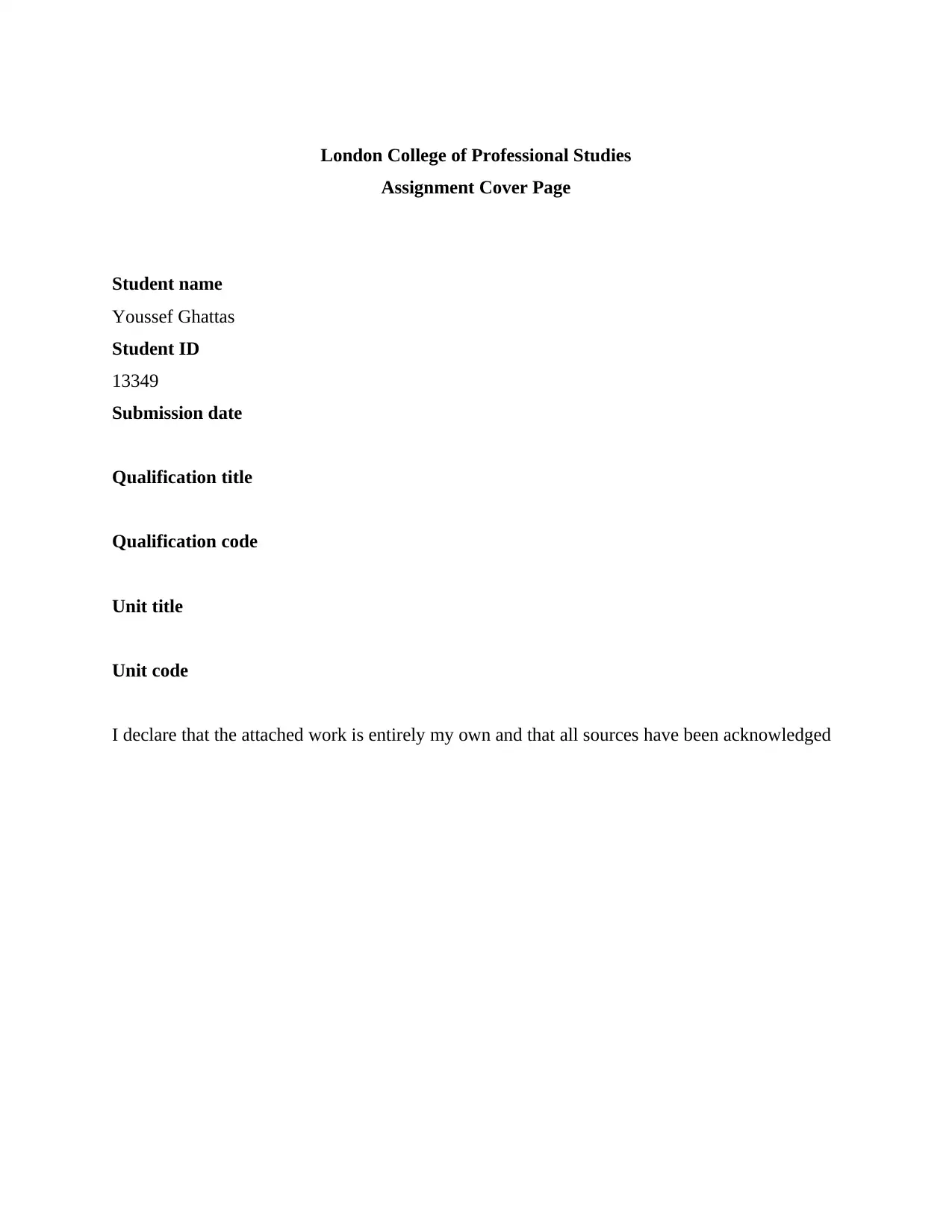
London College of Professional Studies
Assignment Cover Page
Student name
Youssef Ghattas
Student ID
13349
Submission date
Qualification title
Qualification code
Unit title
Unit code
I declare that the attached work is entirely my own and that all sources have been acknowledged
Assignment Cover Page
Student name
Youssef Ghattas
Student ID
13349
Submission date
Qualification title
Qualification code
Unit title
Unit code
I declare that the attached work is entirely my own and that all sources have been acknowledged
Secure Best Marks with AI Grader
Need help grading? Try our AI Grader for instant feedback on your assignments.

PROJECT 4
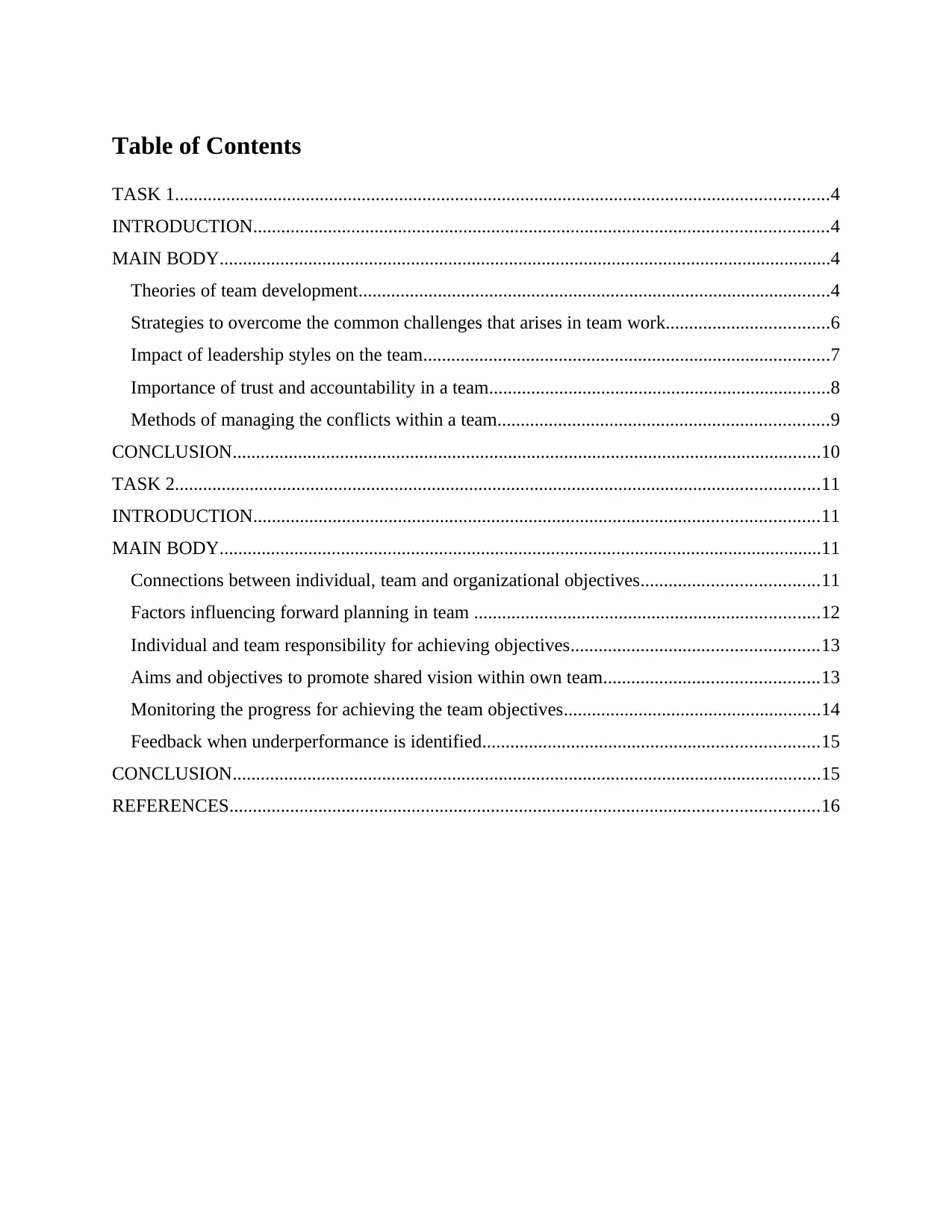
Table of Contents
TASK 1............................................................................................................................................4
INTRODUCTION...........................................................................................................................4
MAIN BODY...................................................................................................................................4
Theories of team development.....................................................................................................4
Strategies to overcome the common challenges that arises in team work...................................6
Impact of leadership styles on the team.......................................................................................7
Importance of trust and accountability in a team.........................................................................8
Methods of managing the conflicts within a team.......................................................................9
CONCLUSION..............................................................................................................................10
TASK 2..........................................................................................................................................11
INTRODUCTION.........................................................................................................................11
MAIN BODY.................................................................................................................................11
Connections between individual, team and organizational objectives......................................11
Factors influencing forward planning in team ..........................................................................12
Individual and team responsibility for achieving objectives.....................................................13
Aims and objectives to promote shared vision within own team..............................................13
Monitoring the progress for achieving the team objectives.......................................................14
Feedback when underperformance is identified........................................................................15
CONCLUSION..............................................................................................................................15
REFERENCES..............................................................................................................................16
TASK 1............................................................................................................................................4
INTRODUCTION...........................................................................................................................4
MAIN BODY...................................................................................................................................4
Theories of team development.....................................................................................................4
Strategies to overcome the common challenges that arises in team work...................................6
Impact of leadership styles on the team.......................................................................................7
Importance of trust and accountability in a team.........................................................................8
Methods of managing the conflicts within a team.......................................................................9
CONCLUSION..............................................................................................................................10
TASK 2..........................................................................................................................................11
INTRODUCTION.........................................................................................................................11
MAIN BODY.................................................................................................................................11
Connections between individual, team and organizational objectives......................................11
Factors influencing forward planning in team ..........................................................................12
Individual and team responsibility for achieving objectives.....................................................13
Aims and objectives to promote shared vision within own team..............................................13
Monitoring the progress for achieving the team objectives.......................................................14
Feedback when underperformance is identified........................................................................15
CONCLUSION..............................................................................................................................15
REFERENCES..............................................................................................................................16
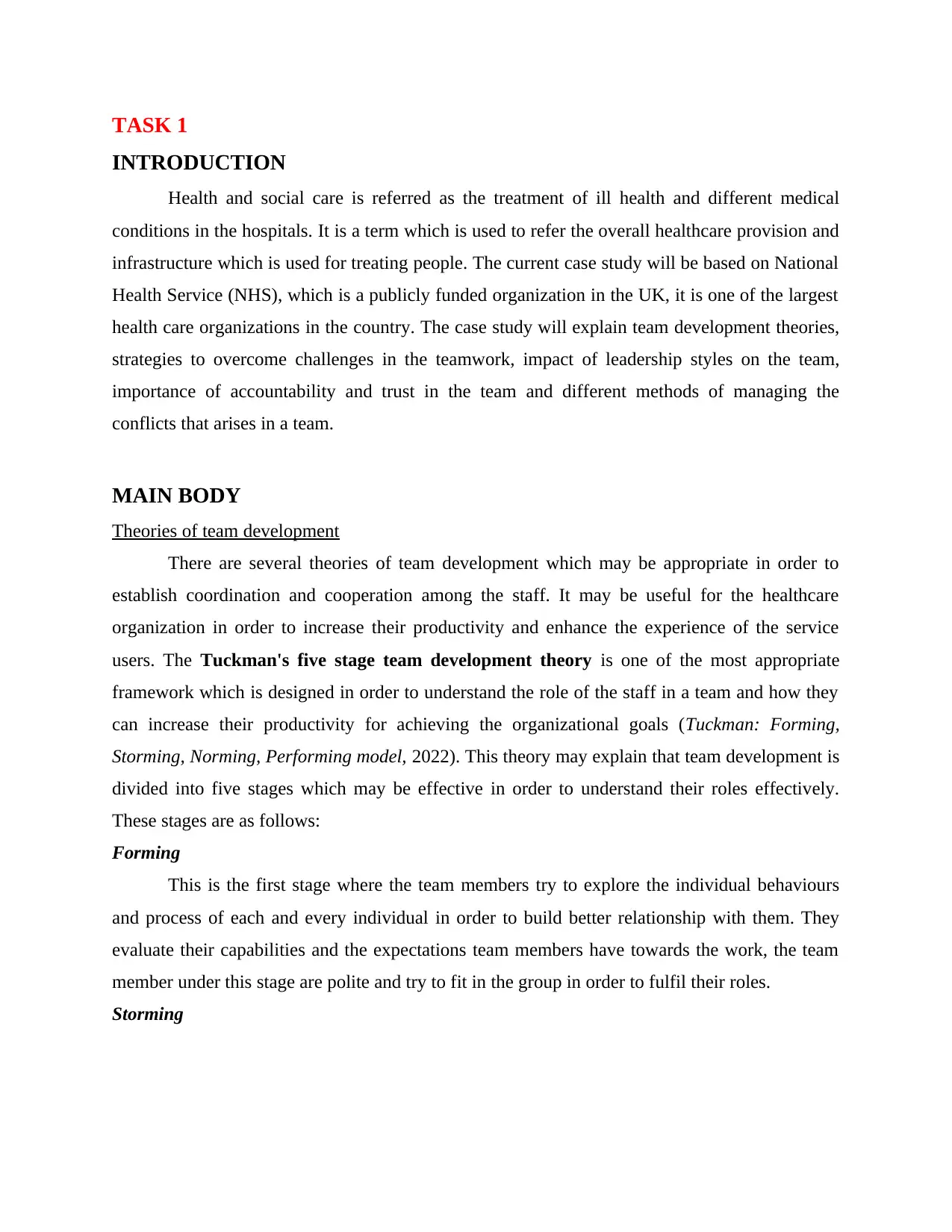
TASK 1
INTRODUCTION
Health and social care is referred as the treatment of ill health and different medical
conditions in the hospitals. It is a term which is used to refer the overall healthcare provision and
infrastructure which is used for treating people. The current case study will be based on National
Health Service (NHS), which is a publicly funded organization in the UK, it is one of the largest
health care organizations in the country. The case study will explain team development theories,
strategies to overcome challenges in the teamwork, impact of leadership styles on the team,
importance of accountability and trust in the team and different methods of managing the
conflicts that arises in a team.
MAIN BODY
Theories of team development
There are several theories of team development which may be appropriate in order to
establish coordination and cooperation among the staff. It may be useful for the healthcare
organization in order to increase their productivity and enhance the experience of the service
users. The Tuckman's five stage team development theory is one of the most appropriate
framework which is designed in order to understand the role of the staff in a team and how they
can increase their productivity for achieving the organizational goals (Tuckman: Forming,
Storming, Norming, Performing model, 2022). This theory may explain that team development is
divided into five stages which may be effective in order to understand their roles effectively.
These stages are as follows:
Forming
This is the first stage where the team members try to explore the individual behaviours
and process of each and every individual in order to build better relationship with them. They
evaluate their capabilities and the expectations team members have towards the work, the team
member under this stage are polite and try to fit in the group in order to fulfil their roles.
Storming
INTRODUCTION
Health and social care is referred as the treatment of ill health and different medical
conditions in the hospitals. It is a term which is used to refer the overall healthcare provision and
infrastructure which is used for treating people. The current case study will be based on National
Health Service (NHS), which is a publicly funded organization in the UK, it is one of the largest
health care organizations in the country. The case study will explain team development theories,
strategies to overcome challenges in the teamwork, impact of leadership styles on the team,
importance of accountability and trust in the team and different methods of managing the
conflicts that arises in a team.
MAIN BODY
Theories of team development
There are several theories of team development which may be appropriate in order to
establish coordination and cooperation among the staff. It may be useful for the healthcare
organization in order to increase their productivity and enhance the experience of the service
users. The Tuckman's five stage team development theory is one of the most appropriate
framework which is designed in order to understand the role of the staff in a team and how they
can increase their productivity for achieving the organizational goals (Tuckman: Forming,
Storming, Norming, Performing model, 2022). This theory may explain that team development is
divided into five stages which may be effective in order to understand their roles effectively.
These stages are as follows:
Forming
This is the first stage where the team members try to explore the individual behaviours
and process of each and every individual in order to build better relationship with them. They
evaluate their capabilities and the expectations team members have towards the work, the team
member under this stage are polite and try to fit in the group in order to fulfil their roles.
Storming
Secure Best Marks with AI Grader
Need help grading? Try our AI Grader for instant feedback on your assignments.
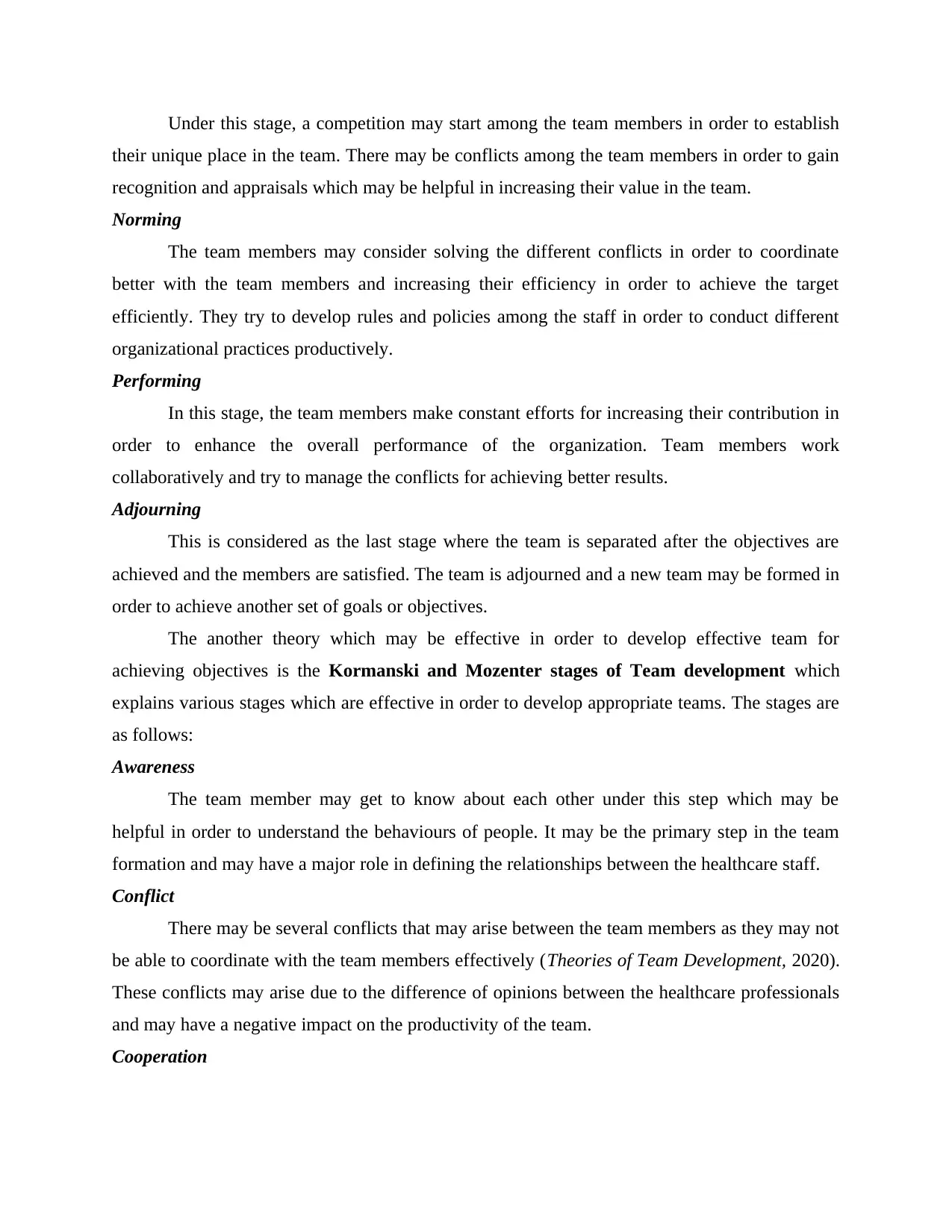
Under this stage, a competition may start among the team members in order to establish
their unique place in the team. There may be conflicts among the team members in order to gain
recognition and appraisals which may be helpful in increasing their value in the team.
Norming
The team members may consider solving the different conflicts in order to coordinate
better with the team members and increasing their efficiency in order to achieve the target
efficiently. They try to develop rules and policies among the staff in order to conduct different
organizational practices productively.
Performing
In this stage, the team members make constant efforts for increasing their contribution in
order to enhance the overall performance of the organization. Team members work
collaboratively and try to manage the conflicts for achieving better results.
Adjourning
This is considered as the last stage where the team is separated after the objectives are
achieved and the members are satisfied. The team is adjourned and a new team may be formed in
order to achieve another set of goals or objectives.
The another theory which may be effective in order to develop effective team for
achieving objectives is the Kormanski and Mozenter stages of Team development which
explains various stages which are effective in order to develop appropriate teams. The stages are
as follows:
Awareness
The team member may get to know about each other under this step which may be
helpful in order to understand the behaviours of people. It may be the primary step in the team
formation and may have a major role in defining the relationships between the healthcare staff.
Conflict
There may be several conflicts that may arise between the team members as they may not
be able to coordinate with the team members effectively (Theories of Team Development, 2020).
These conflicts may arise due to the difference of opinions between the healthcare professionals
and may have a negative impact on the productivity of the team.
Cooperation
their unique place in the team. There may be conflicts among the team members in order to gain
recognition and appraisals which may be helpful in increasing their value in the team.
Norming
The team members may consider solving the different conflicts in order to coordinate
better with the team members and increasing their efficiency in order to achieve the target
efficiently. They try to develop rules and policies among the staff in order to conduct different
organizational practices productively.
Performing
In this stage, the team members make constant efforts for increasing their contribution in
order to enhance the overall performance of the organization. Team members work
collaboratively and try to manage the conflicts for achieving better results.
Adjourning
This is considered as the last stage where the team is separated after the objectives are
achieved and the members are satisfied. The team is adjourned and a new team may be formed in
order to achieve another set of goals or objectives.
The another theory which may be effective in order to develop effective team for
achieving objectives is the Kormanski and Mozenter stages of Team development which
explains various stages which are effective in order to develop appropriate teams. The stages are
as follows:
Awareness
The team member may get to know about each other under this step which may be
helpful in order to understand the behaviours of people. It may be the primary step in the team
formation and may have a major role in defining the relationships between the healthcare staff.
Conflict
There may be several conflicts that may arise between the team members as they may not
be able to coordinate with the team members effectively (Theories of Team Development, 2020).
These conflicts may arise due to the difference of opinions between the healthcare professionals
and may have a negative impact on the productivity of the team.
Cooperation
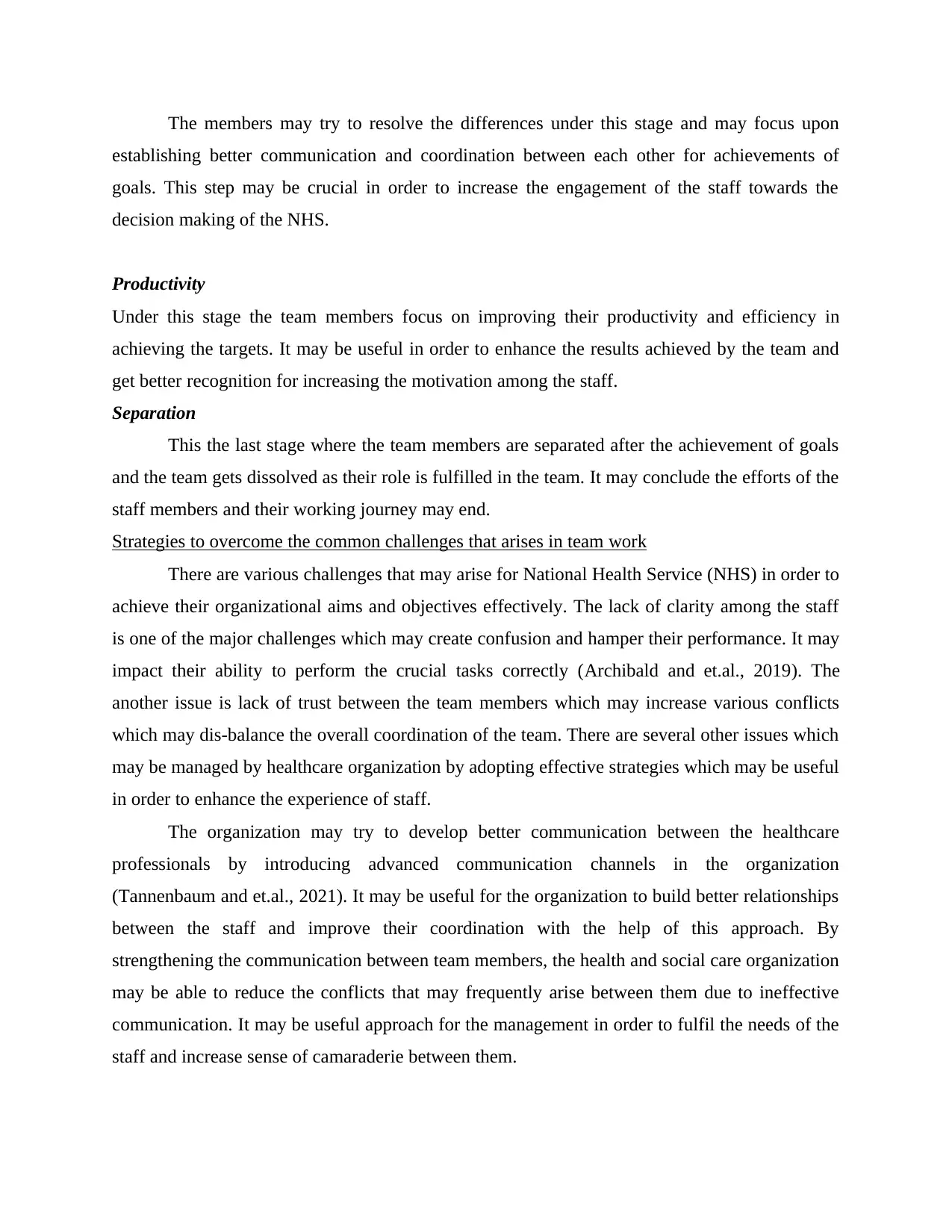
The members may try to resolve the differences under this stage and may focus upon
establishing better communication and coordination between each other for achievements of
goals. This step may be crucial in order to increase the engagement of the staff towards the
decision making of the NHS.
Productivity
Under this stage the team members focus on improving their productivity and efficiency in
achieving the targets. It may be useful in order to enhance the results achieved by the team and
get better recognition for increasing the motivation among the staff.
Separation
This the last stage where the team members are separated after the achievement of goals
and the team gets dissolved as their role is fulfilled in the team. It may conclude the efforts of the
staff members and their working journey may end.
Strategies to overcome the common challenges that arises in team work
There are various challenges that may arise for National Health Service (NHS) in order to
achieve their organizational aims and objectives effectively. The lack of clarity among the staff
is one of the major challenges which may create confusion and hamper their performance. It may
impact their ability to perform the crucial tasks correctly (Archibald and et.al., 2019). The
another issue is lack of trust between the team members which may increase various conflicts
which may dis-balance the overall coordination of the team. There are several other issues which
may be managed by healthcare organization by adopting effective strategies which may be useful
in order to enhance the experience of staff.
The organization may try to develop better communication between the healthcare
professionals by introducing advanced communication channels in the organization
(Tannenbaum and et.al., 2021). It may be useful for the organization to build better relationships
between the staff and improve their coordination with the help of this approach. By
strengthening the communication between team members, the health and social care organization
may be able to reduce the conflicts that may frequently arise between them due to ineffective
communication. It may be useful approach for the management in order to fulfil the needs of the
staff and increase sense of camaraderie between them.
establishing better communication and coordination between each other for achievements of
goals. This step may be crucial in order to increase the engagement of the staff towards the
decision making of the NHS.
Productivity
Under this stage the team members focus on improving their productivity and efficiency in
achieving the targets. It may be useful in order to enhance the results achieved by the team and
get better recognition for increasing the motivation among the staff.
Separation
This the last stage where the team members are separated after the achievement of goals
and the team gets dissolved as their role is fulfilled in the team. It may conclude the efforts of the
staff members and their working journey may end.
Strategies to overcome the common challenges that arises in team work
There are various challenges that may arise for National Health Service (NHS) in order to
achieve their organizational aims and objectives effectively. The lack of clarity among the staff
is one of the major challenges which may create confusion and hamper their performance. It may
impact their ability to perform the crucial tasks correctly (Archibald and et.al., 2019). The
another issue is lack of trust between the team members which may increase various conflicts
which may dis-balance the overall coordination of the team. There are several other issues which
may be managed by healthcare organization by adopting effective strategies which may be useful
in order to enhance the experience of staff.
The organization may try to develop better communication between the healthcare
professionals by introducing advanced communication channels in the organization
(Tannenbaum and et.al., 2021). It may be useful for the organization to build better relationships
between the staff and improve their coordination with the help of this approach. By
strengthening the communication between team members, the health and social care organization
may be able to reduce the conflicts that may frequently arise between them due to ineffective
communication. It may be useful approach for the management in order to fulfil the needs of the
staff and increase sense of camaraderie between them.
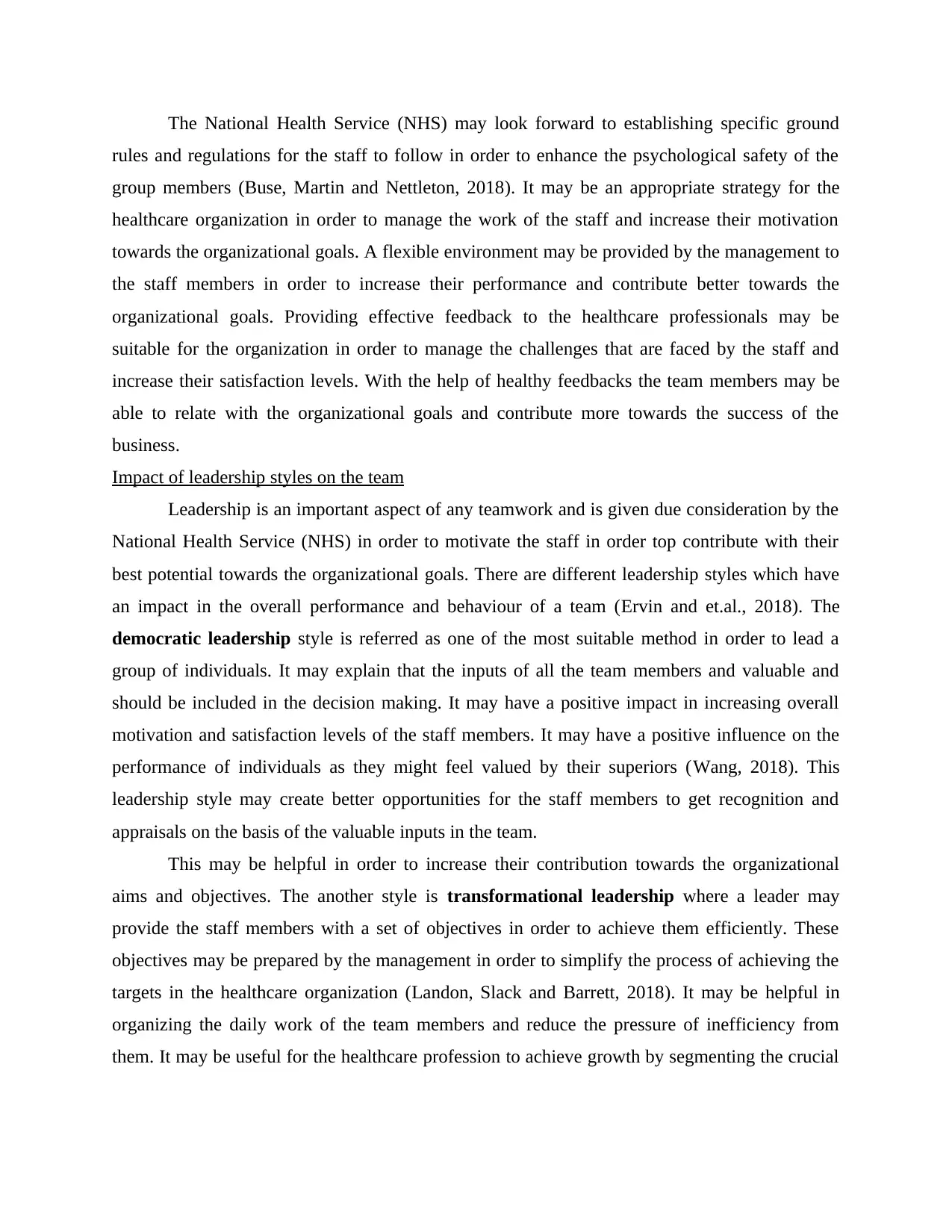
The National Health Service (NHS) may look forward to establishing specific ground
rules and regulations for the staff to follow in order to enhance the psychological safety of the
group members (Buse, Martin and Nettleton, 2018). It may be an appropriate strategy for the
healthcare organization in order to manage the work of the staff and increase their motivation
towards the organizational goals. A flexible environment may be provided by the management to
the staff members in order to increase their performance and contribute better towards the
organizational goals. Providing effective feedback to the healthcare professionals may be
suitable for the organization in order to manage the challenges that are faced by the staff and
increase their satisfaction levels. With the help of healthy feedbacks the team members may be
able to relate with the organizational goals and contribute more towards the success of the
business.
Impact of leadership styles on the team
Leadership is an important aspect of any teamwork and is given due consideration by the
National Health Service (NHS) in order to motivate the staff in order top contribute with their
best potential towards the organizational goals. There are different leadership styles which have
an impact in the overall performance and behaviour of a team (Ervin and et.al., 2018). The
democratic leadership style is referred as one of the most suitable method in order to lead a
group of individuals. It may explain that the inputs of all the team members and valuable and
should be included in the decision making. It may have a positive impact in increasing overall
motivation and satisfaction levels of the staff members. It may have a positive influence on the
performance of individuals as they might feel valued by their superiors (Wang, 2018). This
leadership style may create better opportunities for the staff members to get recognition and
appraisals on the basis of the valuable inputs in the team.
This may be helpful in order to increase their contribution towards the organizational
aims and objectives. The another style is transformational leadership where a leader may
provide the staff members with a set of objectives in order to achieve them efficiently. These
objectives may be prepared by the management in order to simplify the process of achieving the
targets in the healthcare organization (Landon, Slack and Barrett, 2018). It may be helpful in
organizing the daily work of the team members and reduce the pressure of inefficiency from
them. It may be useful for the healthcare profession to achieve growth by segmenting the crucial
rules and regulations for the staff to follow in order to enhance the psychological safety of the
group members (Buse, Martin and Nettleton, 2018). It may be an appropriate strategy for the
healthcare organization in order to manage the work of the staff and increase their motivation
towards the organizational goals. A flexible environment may be provided by the management to
the staff members in order to increase their performance and contribute better towards the
organizational goals. Providing effective feedback to the healthcare professionals may be
suitable for the organization in order to manage the challenges that are faced by the staff and
increase their satisfaction levels. With the help of healthy feedbacks the team members may be
able to relate with the organizational goals and contribute more towards the success of the
business.
Impact of leadership styles on the team
Leadership is an important aspect of any teamwork and is given due consideration by the
National Health Service (NHS) in order to motivate the staff in order top contribute with their
best potential towards the organizational goals. There are different leadership styles which have
an impact in the overall performance and behaviour of a team (Ervin and et.al., 2018). The
democratic leadership style is referred as one of the most suitable method in order to lead a
group of individuals. It may explain that the inputs of all the team members and valuable and
should be included in the decision making. It may have a positive impact in increasing overall
motivation and satisfaction levels of the staff members. It may have a positive influence on the
performance of individuals as they might feel valued by their superiors (Wang, 2018). This
leadership style may create better opportunities for the staff members to get recognition and
appraisals on the basis of the valuable inputs in the team.
This may be helpful in order to increase their contribution towards the organizational
aims and objectives. The another style is transformational leadership where a leader may
provide the staff members with a set of objectives in order to achieve them efficiently. These
objectives may be prepared by the management in order to simplify the process of achieving the
targets in the healthcare organization (Landon, Slack and Barrett, 2018). It may be helpful in
organizing the daily work of the team members and reduce the pressure of inefficiency from
them. It may be useful for the healthcare profession to achieve growth by segmenting the crucial
Paraphrase This Document
Need a fresh take? Get an instant paraphrase of this document with our AI Paraphraser
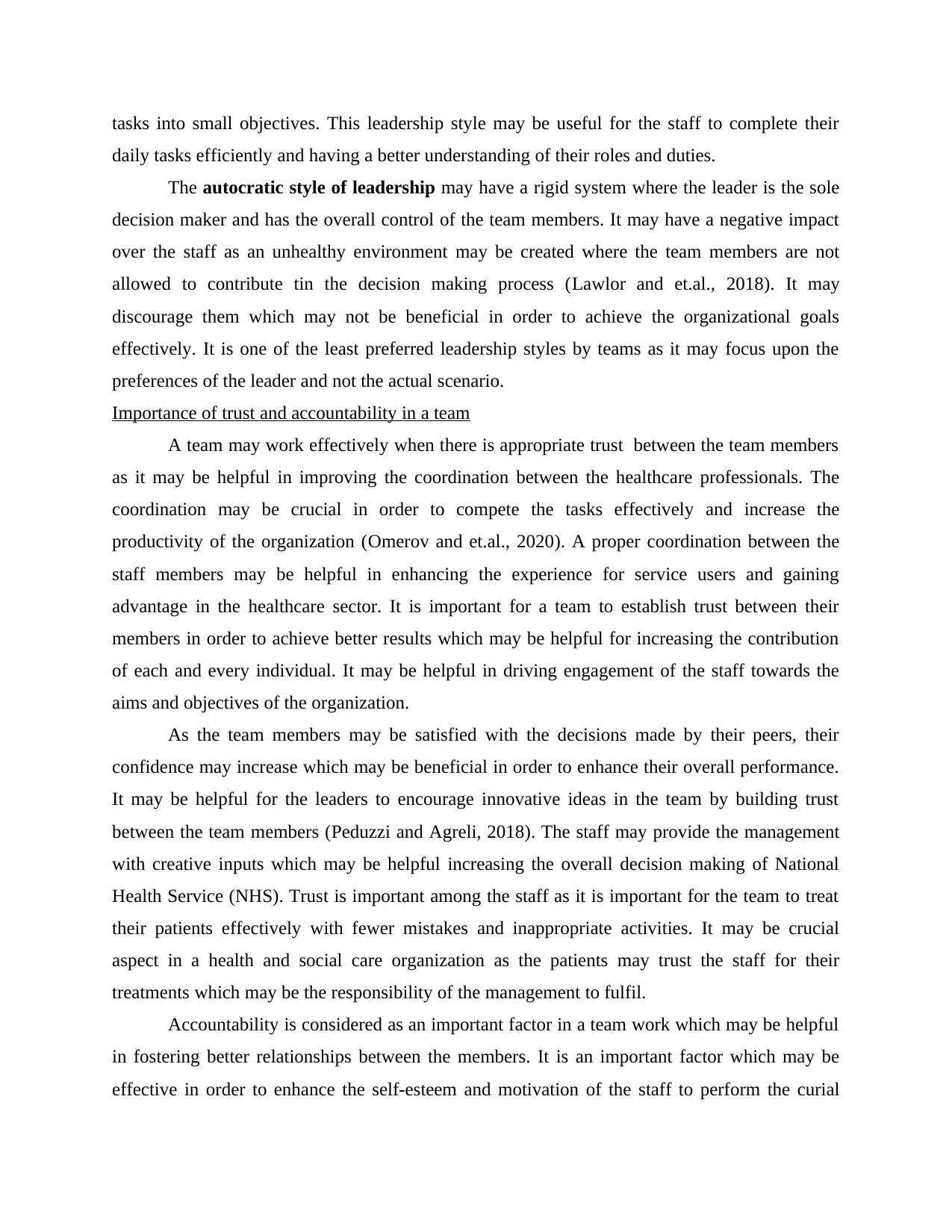
tasks into small objectives. This leadership style may be useful for the staff to complete their
daily tasks efficiently and having a better understanding of their roles and duties.
The autocratic style of leadership may have a rigid system where the leader is the sole
decision maker and has the overall control of the team members. It may have a negative impact
over the staff as an unhealthy environment may be created where the team members are not
allowed to contribute tin the decision making process (Lawlor and et.al., 2018). It may
discourage them which may not be beneficial in order to achieve the organizational goals
effectively. It is one of the least preferred leadership styles by teams as it may focus upon the
preferences of the leader and not the actual scenario.
Importance of trust and accountability in a team
A team may work effectively when there is appropriate trust between the team members
as it may be helpful in improving the coordination between the healthcare professionals. The
coordination may be crucial in order to compete the tasks effectively and increase the
productivity of the organization (Omerov and et.al., 2020). A proper coordination between the
staff members may be helpful in enhancing the experience for service users and gaining
advantage in the healthcare sector. It is important for a team to establish trust between their
members in order to achieve better results which may be helpful for increasing the contribution
of each and every individual. It may be helpful in driving engagement of the staff towards the
aims and objectives of the organization.
As the team members may be satisfied with the decisions made by their peers, their
confidence may increase which may be beneficial in order to enhance their overall performance.
It may be helpful for the leaders to encourage innovative ideas in the team by building trust
between the team members (Peduzzi and Agreli, 2018). The staff may provide the management
with creative inputs which may be helpful increasing the overall decision making of National
Health Service (NHS). Trust is important among the staff as it is important for the team to treat
their patients effectively with fewer mistakes and inappropriate activities. It may be crucial
aspect in a health and social care organization as the patients may trust the staff for their
treatments which may be the responsibility of the management to fulfil.
Accountability is considered as an important factor in a team work which may be helpful
in fostering better relationships between the members. It is an important factor which may be
effective in order to enhance the self-esteem and motivation of the staff to perform the curial
daily tasks efficiently and having a better understanding of their roles and duties.
The autocratic style of leadership may have a rigid system where the leader is the sole
decision maker and has the overall control of the team members. It may have a negative impact
over the staff as an unhealthy environment may be created where the team members are not
allowed to contribute tin the decision making process (Lawlor and et.al., 2018). It may
discourage them which may not be beneficial in order to achieve the organizational goals
effectively. It is one of the least preferred leadership styles by teams as it may focus upon the
preferences of the leader and not the actual scenario.
Importance of trust and accountability in a team
A team may work effectively when there is appropriate trust between the team members
as it may be helpful in improving the coordination between the healthcare professionals. The
coordination may be crucial in order to compete the tasks effectively and increase the
productivity of the organization (Omerov and et.al., 2020). A proper coordination between the
staff members may be helpful in enhancing the experience for service users and gaining
advantage in the healthcare sector. It is important for a team to establish trust between their
members in order to achieve better results which may be helpful for increasing the contribution
of each and every individual. It may be helpful in driving engagement of the staff towards the
aims and objectives of the organization.
As the team members may be satisfied with the decisions made by their peers, their
confidence may increase which may be beneficial in order to enhance their overall performance.
It may be helpful for the leaders to encourage innovative ideas in the team by building trust
between the team members (Peduzzi and Agreli, 2018). The staff may provide the management
with creative inputs which may be helpful increasing the overall decision making of National
Health Service (NHS). Trust is important among the staff as it is important for the team to treat
their patients effectively with fewer mistakes and inappropriate activities. It may be crucial
aspect in a health and social care organization as the patients may trust the staff for their
treatments which may be the responsibility of the management to fulfil.
Accountability is considered as an important factor in a team work which may be helpful
in fostering better relationships between the members. It is an important factor which may be
effective in order to enhance the self-esteem and motivation of the staff to perform the curial
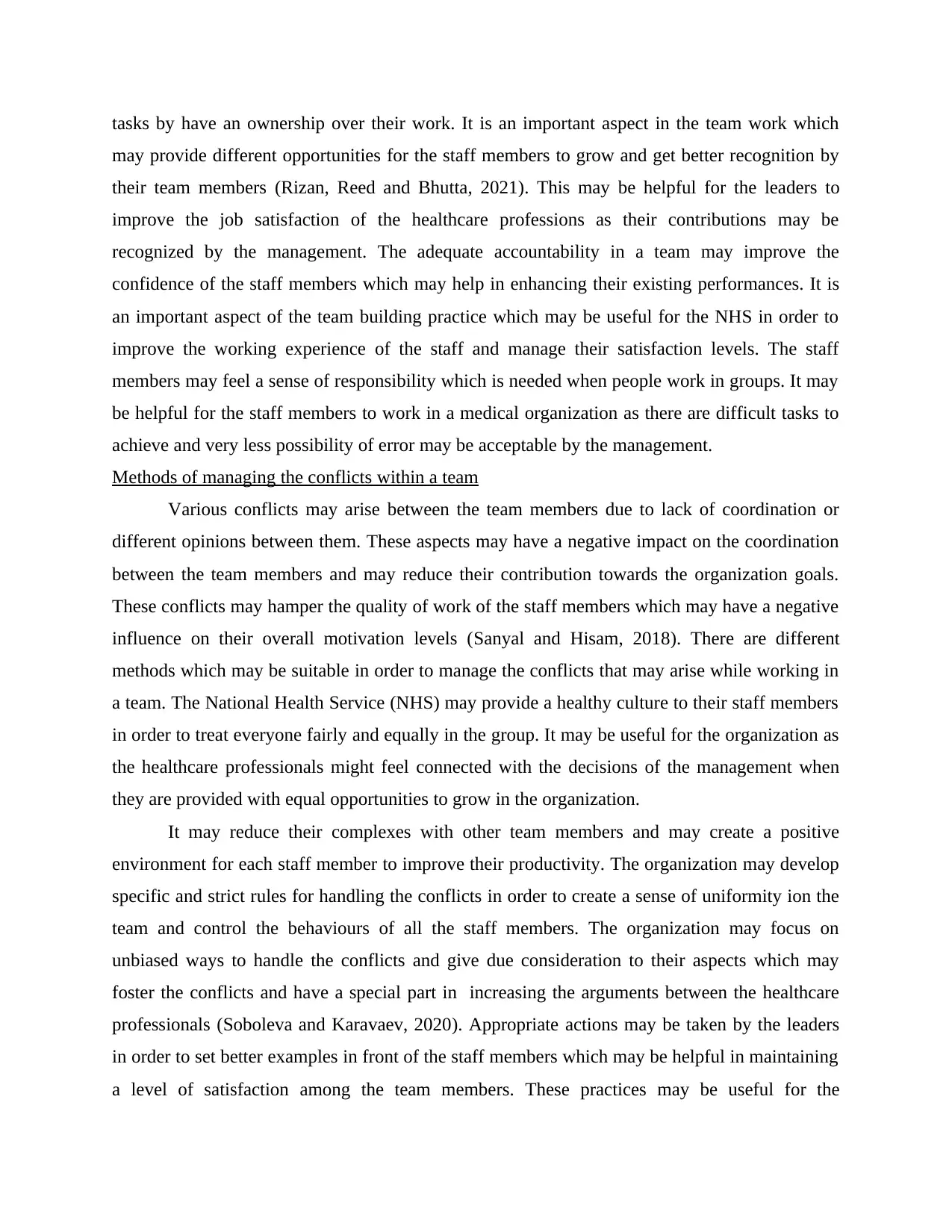
tasks by have an ownership over their work. It is an important aspect in the team work which
may provide different opportunities for the staff members to grow and get better recognition by
their team members (Rizan, Reed and Bhutta, 2021). This may be helpful for the leaders to
improve the job satisfaction of the healthcare professions as their contributions may be
recognized by the management. The adequate accountability in a team may improve the
confidence of the staff members which may help in enhancing their existing performances. It is
an important aspect of the team building practice which may be useful for the NHS in order to
improve the working experience of the staff and manage their satisfaction levels. The staff
members may feel a sense of responsibility which is needed when people work in groups. It may
be helpful for the staff members to work in a medical organization as there are difficult tasks to
achieve and very less possibility of error may be acceptable by the management.
Methods of managing the conflicts within a team
Various conflicts may arise between the team members due to lack of coordination or
different opinions between them. These aspects may have a negative impact on the coordination
between the team members and may reduce their contribution towards the organization goals.
These conflicts may hamper the quality of work of the staff members which may have a negative
influence on their overall motivation levels (Sanyal and Hisam, 2018). There are different
methods which may be suitable in order to manage the conflicts that may arise while working in
a team. The National Health Service (NHS) may provide a healthy culture to their staff members
in order to treat everyone fairly and equally in the group. It may be useful for the organization as
the healthcare professionals might feel connected with the decisions of the management when
they are provided with equal opportunities to grow in the organization.
It may reduce their complexes with other team members and may create a positive
environment for each staff member to improve their productivity. The organization may develop
specific and strict rules for handling the conflicts in order to create a sense of uniformity ion the
team and control the behaviours of all the staff members. The organization may focus on
unbiased ways to handle the conflicts and give due consideration to their aspects which may
foster the conflicts and have a special part in increasing the arguments between the healthcare
professionals (Soboleva and Karavaev, 2020). Appropriate actions may be taken by the leaders
in order to set better examples in front of the staff members which may be helpful in maintaining
a level of satisfaction among the team members. These practices may be useful for the
may provide different opportunities for the staff members to grow and get better recognition by
their team members (Rizan, Reed and Bhutta, 2021). This may be helpful for the leaders to
improve the job satisfaction of the healthcare professions as their contributions may be
recognized by the management. The adequate accountability in a team may improve the
confidence of the staff members which may help in enhancing their existing performances. It is
an important aspect of the team building practice which may be useful for the NHS in order to
improve the working experience of the staff and manage their satisfaction levels. The staff
members may feel a sense of responsibility which is needed when people work in groups. It may
be helpful for the staff members to work in a medical organization as there are difficult tasks to
achieve and very less possibility of error may be acceptable by the management.
Methods of managing the conflicts within a team
Various conflicts may arise between the team members due to lack of coordination or
different opinions between them. These aspects may have a negative impact on the coordination
between the team members and may reduce their contribution towards the organization goals.
These conflicts may hamper the quality of work of the staff members which may have a negative
influence on their overall motivation levels (Sanyal and Hisam, 2018). There are different
methods which may be suitable in order to manage the conflicts that may arise while working in
a team. The National Health Service (NHS) may provide a healthy culture to their staff members
in order to treat everyone fairly and equally in the group. It may be useful for the organization as
the healthcare professionals might feel connected with the decisions of the management when
they are provided with equal opportunities to grow in the organization.
It may reduce their complexes with other team members and may create a positive
environment for each staff member to improve their productivity. The organization may develop
specific and strict rules for handling the conflicts in order to create a sense of uniformity ion the
team and control the behaviours of all the staff members. The organization may focus on
unbiased ways to handle the conflicts and give due consideration to their aspects which may
foster the conflicts and have a special part in increasing the arguments between the healthcare
professionals (Soboleva and Karavaev, 2020). Appropriate actions may be taken by the leaders
in order to set better examples in front of the staff members which may be helpful in maintaining
a level of satisfaction among the team members. These practices may be useful for the
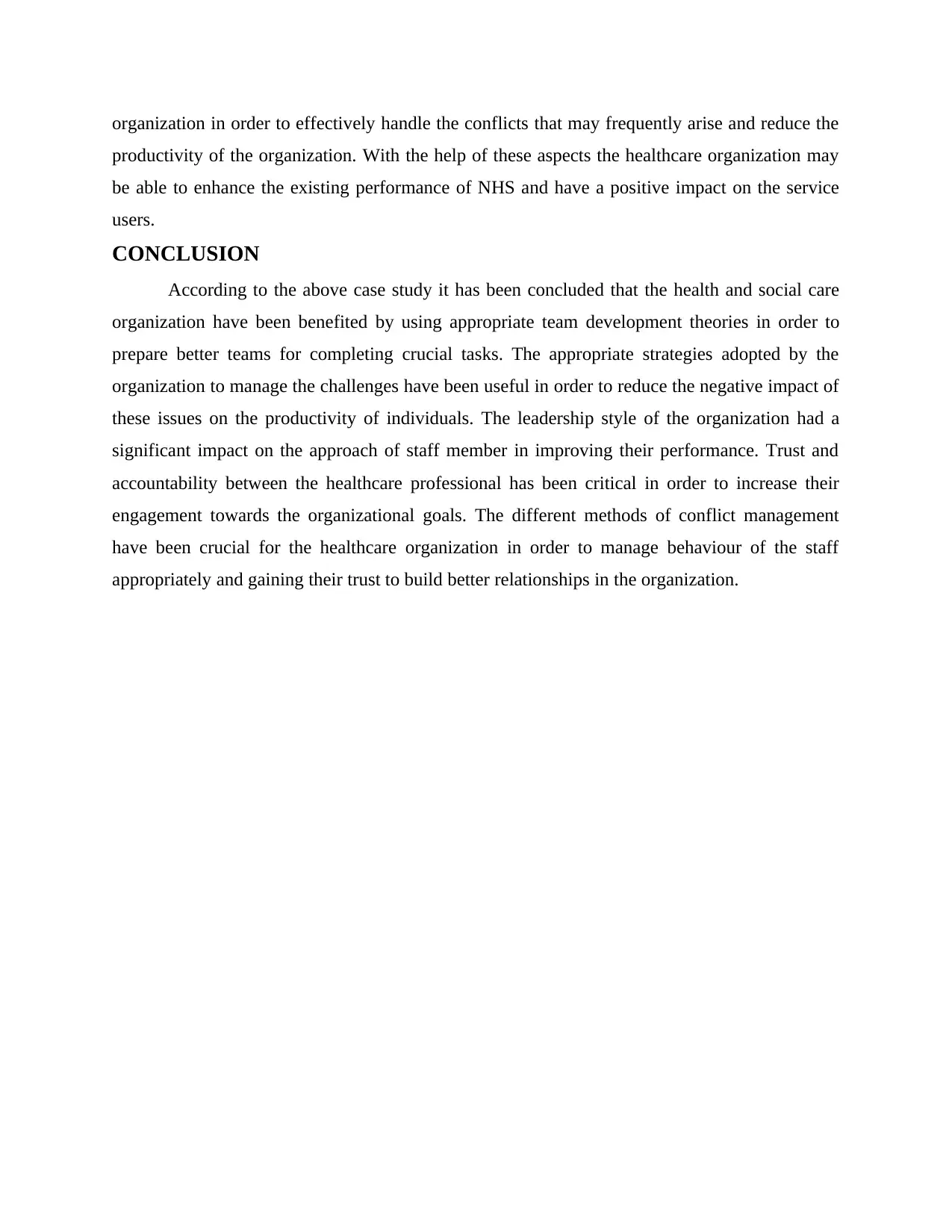
organization in order to effectively handle the conflicts that may frequently arise and reduce the
productivity of the organization. With the help of these aspects the healthcare organization may
be able to enhance the existing performance of NHS and have a positive impact on the service
users.
CONCLUSION
According to the above case study it has been concluded that the health and social care
organization have been benefited by using appropriate team development theories in order to
prepare better teams for completing crucial tasks. The appropriate strategies adopted by the
organization to manage the challenges have been useful in order to reduce the negative impact of
these issues on the productivity of individuals. The leadership style of the organization had a
significant impact on the approach of staff member in improving their performance. Trust and
accountability between the healthcare professional has been critical in order to increase their
engagement towards the organizational goals. The different methods of conflict management
have been crucial for the healthcare organization in order to manage behaviour of the staff
appropriately and gaining their trust to build better relationships in the organization.
productivity of the organization. With the help of these aspects the healthcare organization may
be able to enhance the existing performance of NHS and have a positive impact on the service
users.
CONCLUSION
According to the above case study it has been concluded that the health and social care
organization have been benefited by using appropriate team development theories in order to
prepare better teams for completing crucial tasks. The appropriate strategies adopted by the
organization to manage the challenges have been useful in order to reduce the negative impact of
these issues on the productivity of individuals. The leadership style of the organization had a
significant impact on the approach of staff member in improving their performance. Trust and
accountability between the healthcare professional has been critical in order to increase their
engagement towards the organizational goals. The different methods of conflict management
have been crucial for the healthcare organization in order to manage behaviour of the staff
appropriately and gaining their trust to build better relationships in the organization.
Secure Best Marks with AI Grader
Need help grading? Try our AI Grader for instant feedback on your assignments.
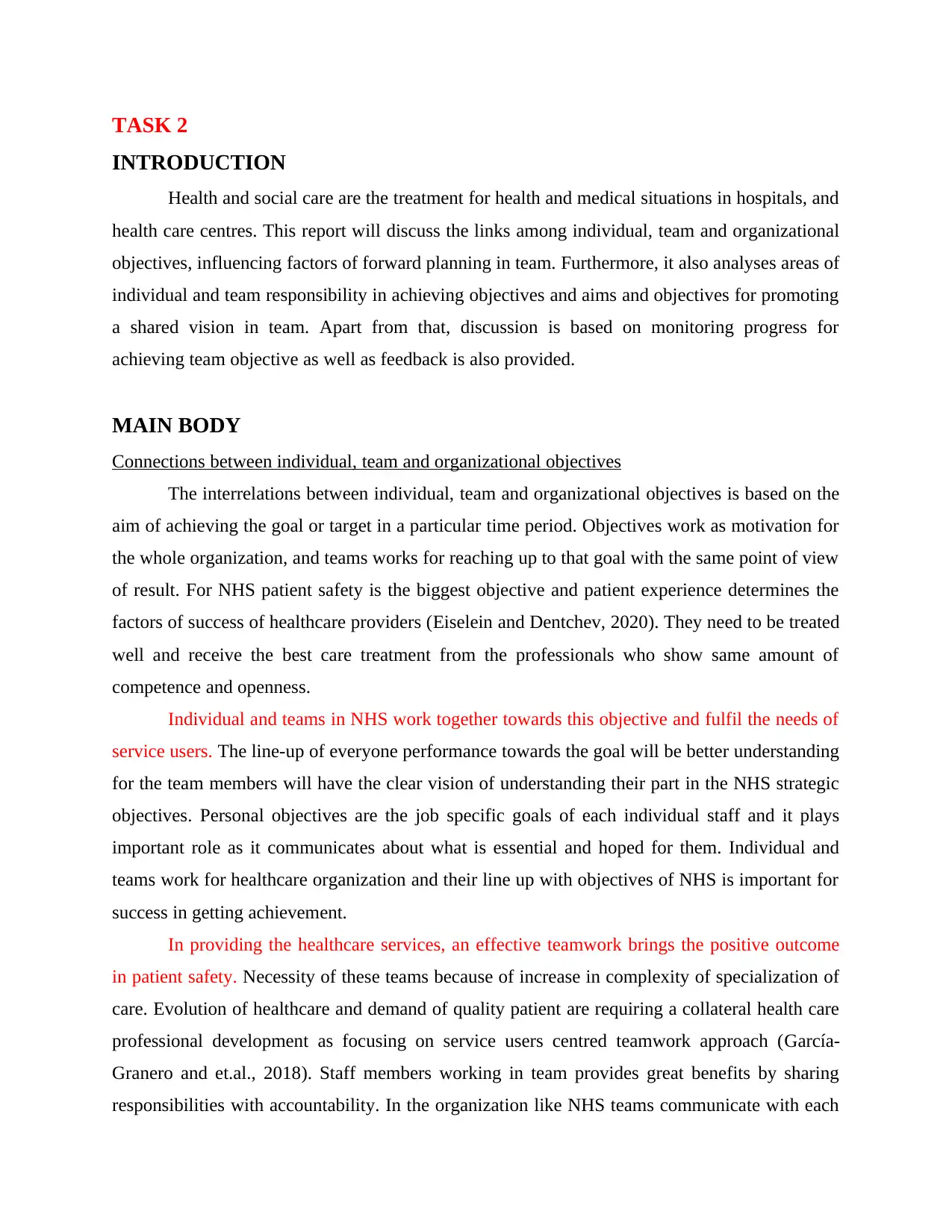
TASK 2
INTRODUCTION
Health and social care are the treatment for health and medical situations in hospitals, and
health care centres. This report will discuss the links among individual, team and organizational
objectives, influencing factors of forward planning in team. Furthermore, it also analyses areas of
individual and team responsibility in achieving objectives and aims and objectives for promoting
a shared vision in team. Apart from that, discussion is based on monitoring progress for
achieving team objective as well as feedback is also provided.
MAIN BODY
Connections between individual, team and organizational objectives
The interrelations between individual, team and organizational objectives is based on the
aim of achieving the goal or target in a particular time period. Objectives work as motivation for
the whole organization, and teams works for reaching up to that goal with the same point of view
of result. For NHS patient safety is the biggest objective and patient experience determines the
factors of success of healthcare providers (Eiselein and Dentchev, 2020). They need to be treated
well and receive the best care treatment from the professionals who show same amount of
competence and openness.
Individual and teams in NHS work together towards this objective and fulfil the needs of
service users. The line-up of everyone performance towards the goal will be better understanding
for the team members will have the clear vision of understanding their part in the NHS strategic
objectives. Personal objectives are the job specific goals of each individual staff and it plays
important role as it communicates about what is essential and hoped for them. Individual and
teams work for healthcare organization and their line up with objectives of NHS is important for
success in getting achievement.
In providing the healthcare services, an effective teamwork brings the positive outcome
in patient safety. Necessity of these teams because of increase in complexity of specialization of
care. Evolution of healthcare and demand of quality patient are requiring a collateral health care
professional development as focusing on service users centred teamwork approach (García-
Granero and et.al., 2018). Staff members working in team provides great benefits by sharing
responsibilities with accountability. In the organization like NHS teams communicate with each
INTRODUCTION
Health and social care are the treatment for health and medical situations in hospitals, and
health care centres. This report will discuss the links among individual, team and organizational
objectives, influencing factors of forward planning in team. Furthermore, it also analyses areas of
individual and team responsibility in achieving objectives and aims and objectives for promoting
a shared vision in team. Apart from that, discussion is based on monitoring progress for
achieving team objective as well as feedback is also provided.
MAIN BODY
Connections between individual, team and organizational objectives
The interrelations between individual, team and organizational objectives is based on the
aim of achieving the goal or target in a particular time period. Objectives work as motivation for
the whole organization, and teams works for reaching up to that goal with the same point of view
of result. For NHS patient safety is the biggest objective and patient experience determines the
factors of success of healthcare providers (Eiselein and Dentchev, 2020). They need to be treated
well and receive the best care treatment from the professionals who show same amount of
competence and openness.
Individual and teams in NHS work together towards this objective and fulfil the needs of
service users. The line-up of everyone performance towards the goal will be better understanding
for the team members will have the clear vision of understanding their part in the NHS strategic
objectives. Personal objectives are the job specific goals of each individual staff and it plays
important role as it communicates about what is essential and hoped for them. Individual and
teams work for healthcare organization and their line up with objectives of NHS is important for
success in getting achievement.
In providing the healthcare services, an effective teamwork brings the positive outcome
in patient safety. Necessity of these teams because of increase in complexity of specialization of
care. Evolution of healthcare and demand of quality patient are requiring a collateral health care
professional development as focusing on service users centred teamwork approach (García-
Granero and et.al., 2018). Staff members working in team provides great benefits by sharing
responsibilities with accountability. In the organization like NHS teams communicate with each
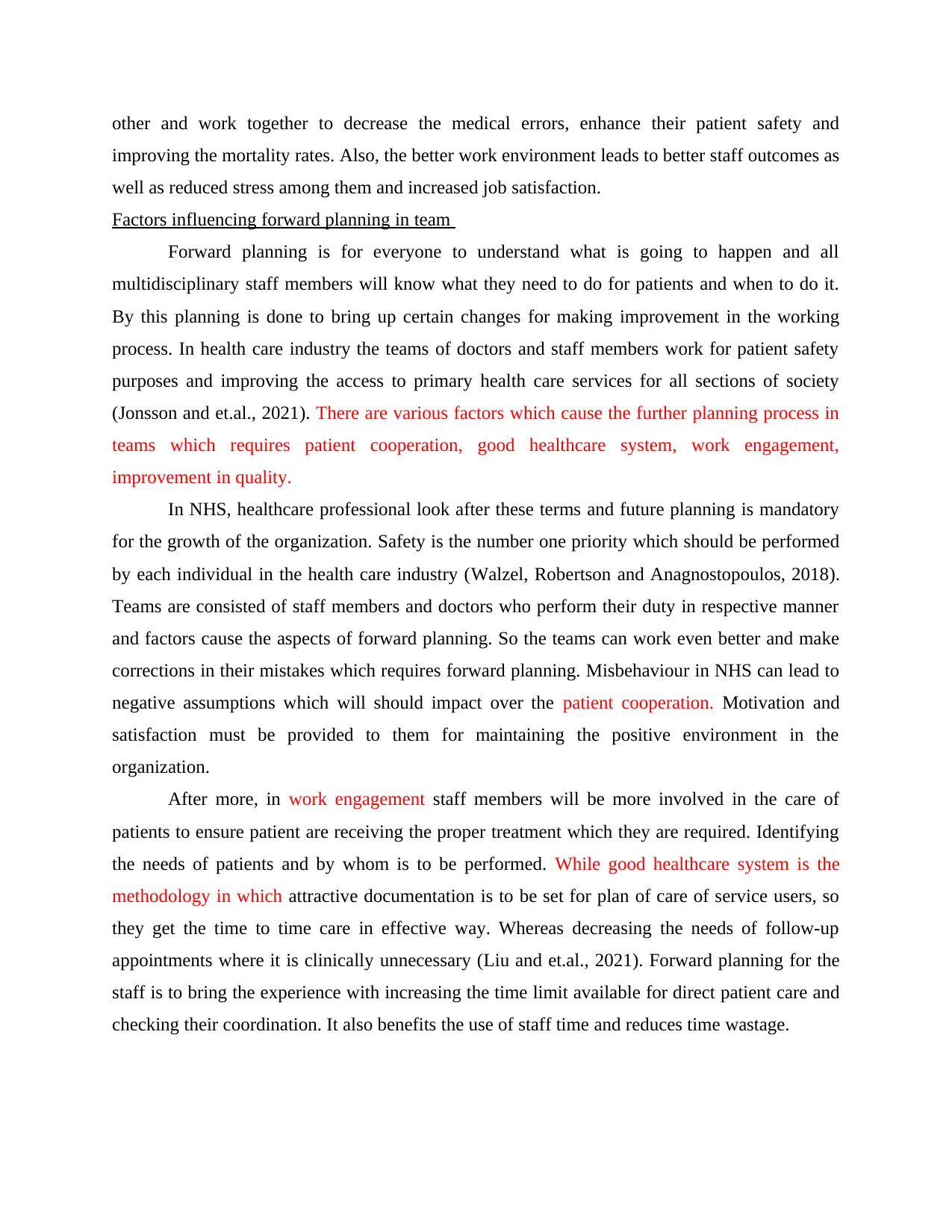
other and work together to decrease the medical errors, enhance their patient safety and
improving the mortality rates. Also, the better work environment leads to better staff outcomes as
well as reduced stress among them and increased job satisfaction.
Factors influencing forward planning in team
Forward planning is for everyone to understand what is going to happen and all
multidisciplinary staff members will know what they need to do for patients and when to do it.
By this planning is done to bring up certain changes for making improvement in the working
process. In health care industry the teams of doctors and staff members work for patient safety
purposes and improving the access to primary health care services for all sections of society
(Jonsson and et.al., 2021). There are various factors which cause the further planning process in
teams which requires patient cooperation, good healthcare system, work engagement,
improvement in quality.
In NHS, healthcare professional look after these terms and future planning is mandatory
for the growth of the organization. Safety is the number one priority which should be performed
by each individual in the health care industry (Walzel, Robertson and Anagnostopoulos, 2018).
Teams are consisted of staff members and doctors who perform their duty in respective manner
and factors cause the aspects of forward planning. So the teams can work even better and make
corrections in their mistakes which requires forward planning. Misbehaviour in NHS can lead to
negative assumptions which will should impact over the patient cooperation. Motivation and
satisfaction must be provided to them for maintaining the positive environment in the
organization.
After more, in work engagement staff members will be more involved in the care of
patients to ensure patient are receiving the proper treatment which they are required. Identifying
the needs of patients and by whom is to be performed. While good healthcare system is the
methodology in which attractive documentation is to be set for plan of care of service users, so
they get the time to time care in effective way. Whereas decreasing the needs of follow-up
appointments where it is clinically unnecessary (Liu and et.al., 2021). Forward planning for the
staff is to bring the experience with increasing the time limit available for direct patient care and
checking their coordination. It also benefits the use of staff time and reduces time wastage.
improving the mortality rates. Also, the better work environment leads to better staff outcomes as
well as reduced stress among them and increased job satisfaction.
Factors influencing forward planning in team
Forward planning is for everyone to understand what is going to happen and all
multidisciplinary staff members will know what they need to do for patients and when to do it.
By this planning is done to bring up certain changes for making improvement in the working
process. In health care industry the teams of doctors and staff members work for patient safety
purposes and improving the access to primary health care services for all sections of society
(Jonsson and et.al., 2021). There are various factors which cause the further planning process in
teams which requires patient cooperation, good healthcare system, work engagement,
improvement in quality.
In NHS, healthcare professional look after these terms and future planning is mandatory
for the growth of the organization. Safety is the number one priority which should be performed
by each individual in the health care industry (Walzel, Robertson and Anagnostopoulos, 2018).
Teams are consisted of staff members and doctors who perform their duty in respective manner
and factors cause the aspects of forward planning. So the teams can work even better and make
corrections in their mistakes which requires forward planning. Misbehaviour in NHS can lead to
negative assumptions which will should impact over the patient cooperation. Motivation and
satisfaction must be provided to them for maintaining the positive environment in the
organization.
After more, in work engagement staff members will be more involved in the care of
patients to ensure patient are receiving the proper treatment which they are required. Identifying
the needs of patients and by whom is to be performed. While good healthcare system is the
methodology in which attractive documentation is to be set for plan of care of service users, so
they get the time to time care in effective way. Whereas decreasing the needs of follow-up
appointments where it is clinically unnecessary (Liu and et.al., 2021). Forward planning for the
staff is to bring the experience with increasing the time limit available for direct patient care and
checking their coordination. It also benefits the use of staff time and reduces time wastage.
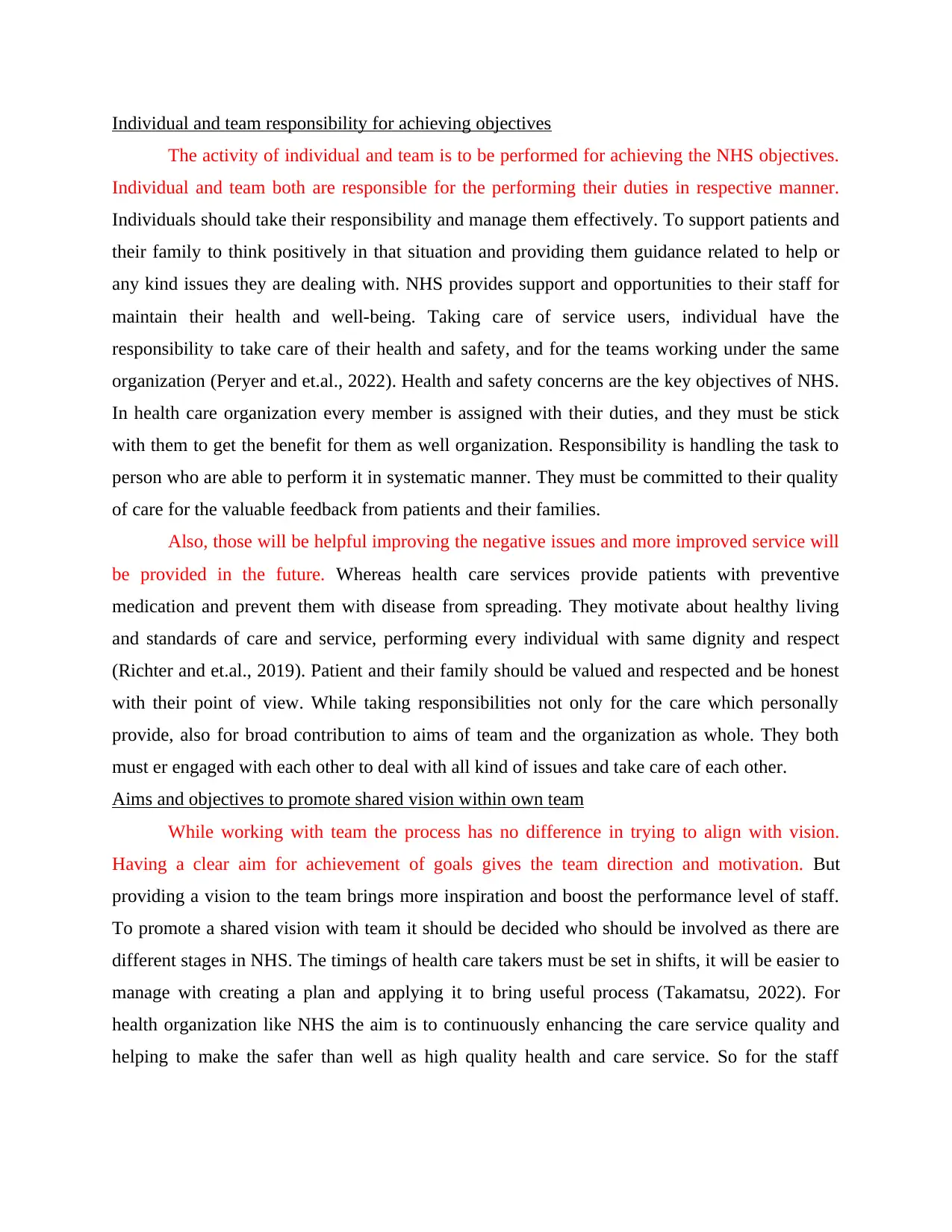
Individual and team responsibility for achieving objectives
The activity of individual and team is to be performed for achieving the NHS objectives.
Individual and team both are responsible for the performing their duties in respective manner.
Individuals should take their responsibility and manage them effectively. To support patients and
their family to think positively in that situation and providing them guidance related to help or
any kind issues they are dealing with. NHS provides support and opportunities to their staff for
maintain their health and well-being. Taking care of service users, individual have the
responsibility to take care of their health and safety, and for the teams working under the same
organization (Peryer and et.al., 2022). Health and safety concerns are the key objectives of NHS.
In health care organization every member is assigned with their duties, and they must be stick
with them to get the benefit for them as well organization. Responsibility is handling the task to
person who are able to perform it in systematic manner. They must be committed to their quality
of care for the valuable feedback from patients and their families.
Also, those will be helpful improving the negative issues and more improved service will
be provided in the future. Whereas health care services provide patients with preventive
medication and prevent them with disease from spreading. They motivate about healthy living
and standards of care and service, performing every individual with same dignity and respect
(Richter and et.al., 2019). Patient and their family should be valued and respected and be honest
with their point of view. While taking responsibilities not only for the care which personally
provide, also for broad contribution to aims of team and the organization as whole. They both
must er engaged with each other to deal with all kind of issues and take care of each other.
Aims and objectives to promote shared vision within own team
While working with team the process has no difference in trying to align with vision.
Having a clear aim for achievement of goals gives the team direction and motivation. But
providing a vision to the team brings more inspiration and boost the performance level of staff.
To promote a shared vision with team it should be decided who should be involved as there are
different stages in NHS. The timings of health care takers must be set in shifts, it will be easier to
manage with creating a plan and applying it to bring useful process (Takamatsu, 2022). For
health organization like NHS the aim is to continuously enhancing the care service quality and
helping to make the safer than well as high quality health and care service. So for the staff
The activity of individual and team is to be performed for achieving the NHS objectives.
Individual and team both are responsible for the performing their duties in respective manner.
Individuals should take their responsibility and manage them effectively. To support patients and
their family to think positively in that situation and providing them guidance related to help or
any kind issues they are dealing with. NHS provides support and opportunities to their staff for
maintain their health and well-being. Taking care of service users, individual have the
responsibility to take care of their health and safety, and for the teams working under the same
organization (Peryer and et.al., 2022). Health and safety concerns are the key objectives of NHS.
In health care organization every member is assigned with their duties, and they must be stick
with them to get the benefit for them as well organization. Responsibility is handling the task to
person who are able to perform it in systematic manner. They must be committed to their quality
of care for the valuable feedback from patients and their families.
Also, those will be helpful improving the negative issues and more improved service will
be provided in the future. Whereas health care services provide patients with preventive
medication and prevent them with disease from spreading. They motivate about healthy living
and standards of care and service, performing every individual with same dignity and respect
(Richter and et.al., 2019). Patient and their family should be valued and respected and be honest
with their point of view. While taking responsibilities not only for the care which personally
provide, also for broad contribution to aims of team and the organization as whole. They both
must er engaged with each other to deal with all kind of issues and take care of each other.
Aims and objectives to promote shared vision within own team
While working with team the process has no difference in trying to align with vision.
Having a clear aim for achievement of goals gives the team direction and motivation. But
providing a vision to the team brings more inspiration and boost the performance level of staff.
To promote a shared vision with team it should be decided who should be involved as there are
different stages in NHS. The timings of health care takers must be set in shifts, it will be easier to
manage with creating a plan and applying it to bring useful process (Takamatsu, 2022). For
health organization like NHS the aim is to continuously enhancing the care service quality and
helping to make the safer than well as high quality health and care service. So for the staff
Paraphrase This Document
Need a fresh take? Get an instant paraphrase of this document with our AI Paraphraser
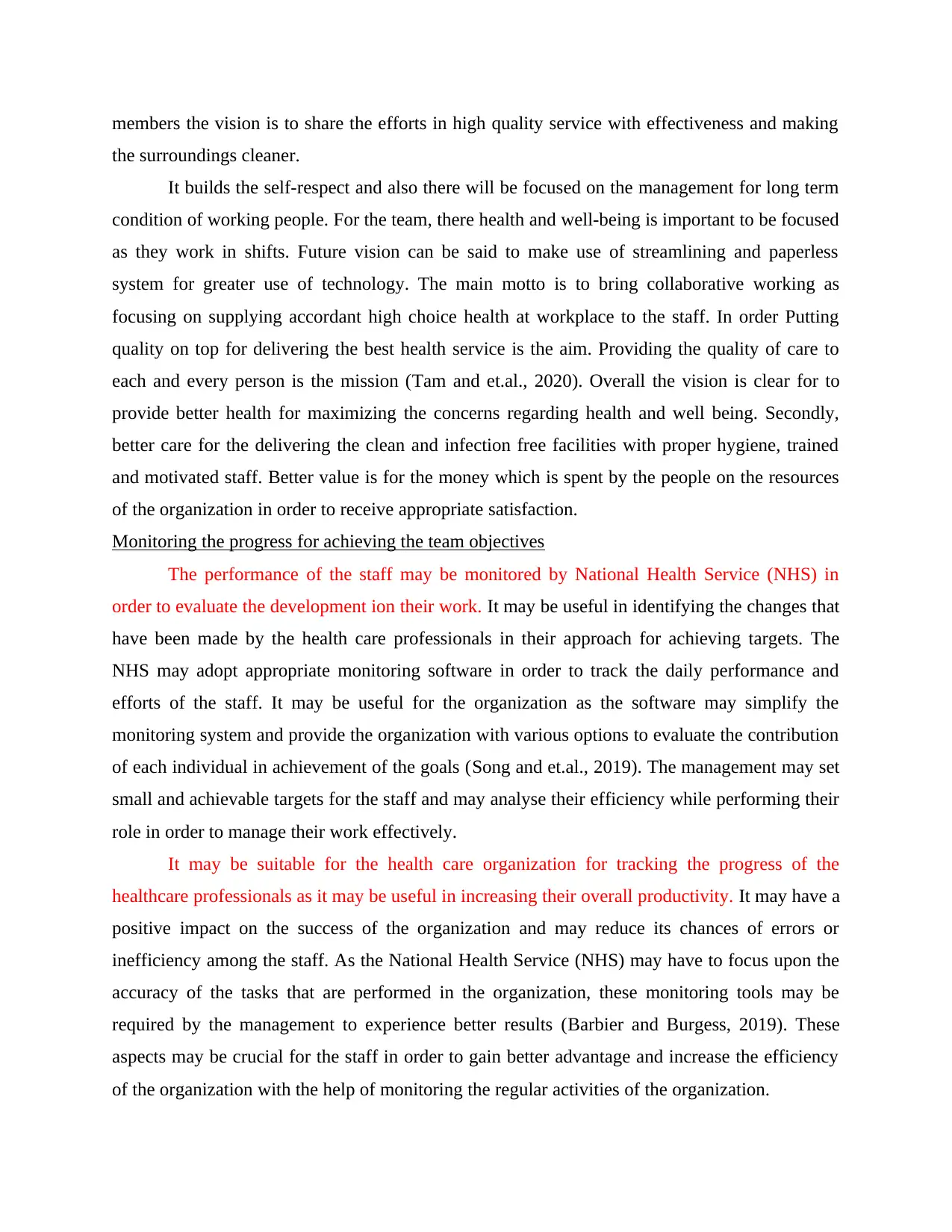
members the vision is to share the efforts in high quality service with effectiveness and making
the surroundings cleaner.
It builds the self-respect and also there will be focused on the management for long term
condition of working people. For the team, there health and well-being is important to be focused
as they work in shifts. Future vision can be said to make use of streamlining and paperless
system for greater use of technology. The main motto is to bring collaborative working as
focusing on supplying accordant high choice health at workplace to the staff. In order Putting
quality on top for delivering the best health service is the aim. Providing the quality of care to
each and every person is the mission (Tam and et.al., 2020). Overall the vision is clear for to
provide better health for maximizing the concerns regarding health and well being. Secondly,
better care for the delivering the clean and infection free facilities with proper hygiene, trained
and motivated staff. Better value is for the money which is spent by the people on the resources
of the organization in order to receive appropriate satisfaction.
Monitoring the progress for achieving the team objectives
The performance of the staff may be monitored by National Health Service (NHS) in
order to evaluate the development ion their work. It may be useful in identifying the changes that
have been made by the health care professionals in their approach for achieving targets. The
NHS may adopt appropriate monitoring software in order to track the daily performance and
efforts of the staff. It may be useful for the organization as the software may simplify the
monitoring system and provide the organization with various options to evaluate the contribution
of each individual in achievement of the goals (Song and et.al., 2019). The management may set
small and achievable targets for the staff and may analyse their efficiency while performing their
role in order to manage their work effectively.
It may be suitable for the health care organization for tracking the progress of the
healthcare professionals as it may be useful in increasing their overall productivity. It may have a
positive impact on the success of the organization and may reduce its chances of errors or
inefficiency among the staff. As the National Health Service (NHS) may have to focus upon the
accuracy of the tasks that are performed in the organization, these monitoring tools may be
required by the management to experience better results (Barbier and Burgess, 2019). These
aspects may be crucial for the staff in order to gain better advantage and increase the efficiency
of the organization with the help of monitoring the regular activities of the organization.
the surroundings cleaner.
It builds the self-respect and also there will be focused on the management for long term
condition of working people. For the team, there health and well-being is important to be focused
as they work in shifts. Future vision can be said to make use of streamlining and paperless
system for greater use of technology. The main motto is to bring collaborative working as
focusing on supplying accordant high choice health at workplace to the staff. In order Putting
quality on top for delivering the best health service is the aim. Providing the quality of care to
each and every person is the mission (Tam and et.al., 2020). Overall the vision is clear for to
provide better health for maximizing the concerns regarding health and well being. Secondly,
better care for the delivering the clean and infection free facilities with proper hygiene, trained
and motivated staff. Better value is for the money which is spent by the people on the resources
of the organization in order to receive appropriate satisfaction.
Monitoring the progress for achieving the team objectives
The performance of the staff may be monitored by National Health Service (NHS) in
order to evaluate the development ion their work. It may be useful in identifying the changes that
have been made by the health care professionals in their approach for achieving targets. The
NHS may adopt appropriate monitoring software in order to track the daily performance and
efforts of the staff. It may be useful for the organization as the software may simplify the
monitoring system and provide the organization with various options to evaluate the contribution
of each individual in achievement of the goals (Song and et.al., 2019). The management may set
small and achievable targets for the staff and may analyse their efficiency while performing their
role in order to manage their work effectively.
It may be suitable for the health care organization for tracking the progress of the
healthcare professionals as it may be useful in increasing their overall productivity. It may have a
positive impact on the success of the organization and may reduce its chances of errors or
inefficiency among the staff. As the National Health Service (NHS) may have to focus upon the
accuracy of the tasks that are performed in the organization, these monitoring tools may be
required by the management to experience better results (Barbier and Burgess, 2019). These
aspects may be crucial for the staff in order to gain better advantage and increase the efficiency
of the organization with the help of monitoring the regular activities of the organization.
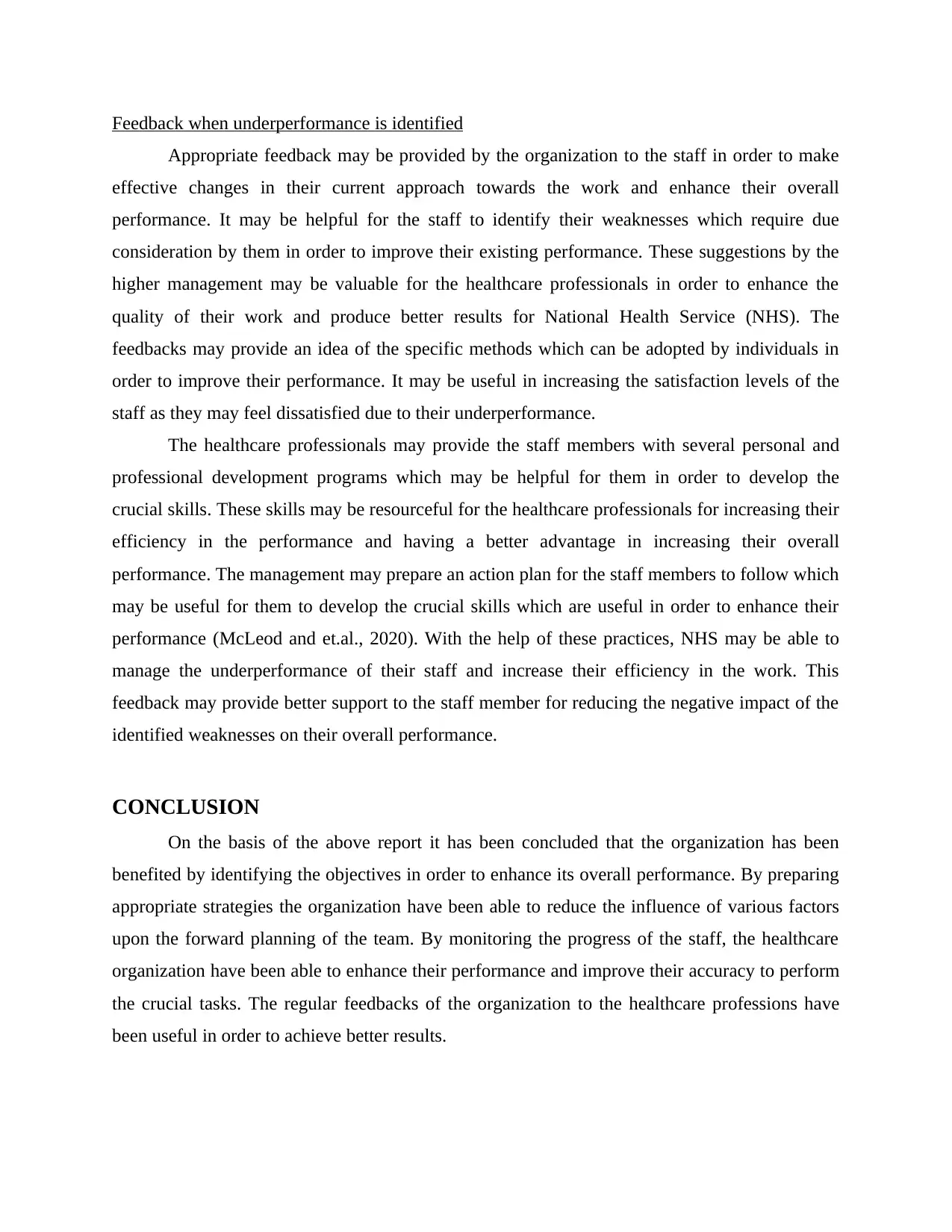
Feedback when underperformance is identified
Appropriate feedback may be provided by the organization to the staff in order to make
effective changes in their current approach towards the work and enhance their overall
performance. It may be helpful for the staff to identify their weaknesses which require due
consideration by them in order to improve their existing performance. These suggestions by the
higher management may be valuable for the healthcare professionals in order to enhance the
quality of their work and produce better results for National Health Service (NHS). The
feedbacks may provide an idea of the specific methods which can be adopted by individuals in
order to improve their performance. It may be useful in increasing the satisfaction levels of the
staff as they may feel dissatisfied due to their underperformance.
The healthcare professionals may provide the staff members with several personal and
professional development programs which may be helpful for them in order to develop the
crucial skills. These skills may be resourceful for the healthcare professionals for increasing their
efficiency in the performance and having a better advantage in increasing their overall
performance. The management may prepare an action plan for the staff members to follow which
may be useful for them to develop the crucial skills which are useful in order to enhance their
performance (McLeod and et.al., 2020). With the help of these practices, NHS may be able to
manage the underperformance of their staff and increase their efficiency in the work. This
feedback may provide better support to the staff member for reducing the negative impact of the
identified weaknesses on their overall performance.
CONCLUSION
On the basis of the above report it has been concluded that the organization has been
benefited by identifying the objectives in order to enhance its overall performance. By preparing
appropriate strategies the organization have been able to reduce the influence of various factors
upon the forward planning of the team. By monitoring the progress of the staff, the healthcare
organization have been able to enhance their performance and improve their accuracy to perform
the crucial tasks. The regular feedbacks of the organization to the healthcare professions have
been useful in order to achieve better results.
Appropriate feedback may be provided by the organization to the staff in order to make
effective changes in their current approach towards the work and enhance their overall
performance. It may be helpful for the staff to identify their weaknesses which require due
consideration by them in order to improve their existing performance. These suggestions by the
higher management may be valuable for the healthcare professionals in order to enhance the
quality of their work and produce better results for National Health Service (NHS). The
feedbacks may provide an idea of the specific methods which can be adopted by individuals in
order to improve their performance. It may be useful in increasing the satisfaction levels of the
staff as they may feel dissatisfied due to their underperformance.
The healthcare professionals may provide the staff members with several personal and
professional development programs which may be helpful for them in order to develop the
crucial skills. These skills may be resourceful for the healthcare professionals for increasing their
efficiency in the performance and having a better advantage in increasing their overall
performance. The management may prepare an action plan for the staff members to follow which
may be useful for them to develop the crucial skills which are useful in order to enhance their
performance (McLeod and et.al., 2020). With the help of these practices, NHS may be able to
manage the underperformance of their staff and increase their efficiency in the work. This
feedback may provide better support to the staff member for reducing the negative impact of the
identified weaknesses on their overall performance.
CONCLUSION
On the basis of the above report it has been concluded that the organization has been
benefited by identifying the objectives in order to enhance its overall performance. By preparing
appropriate strategies the organization have been able to reduce the influence of various factors
upon the forward planning of the team. By monitoring the progress of the staff, the healthcare
organization have been able to enhance their performance and improve their accuracy to perform
the crucial tasks. The regular feedbacks of the organization to the healthcare professions have
been useful in order to achieve better results.
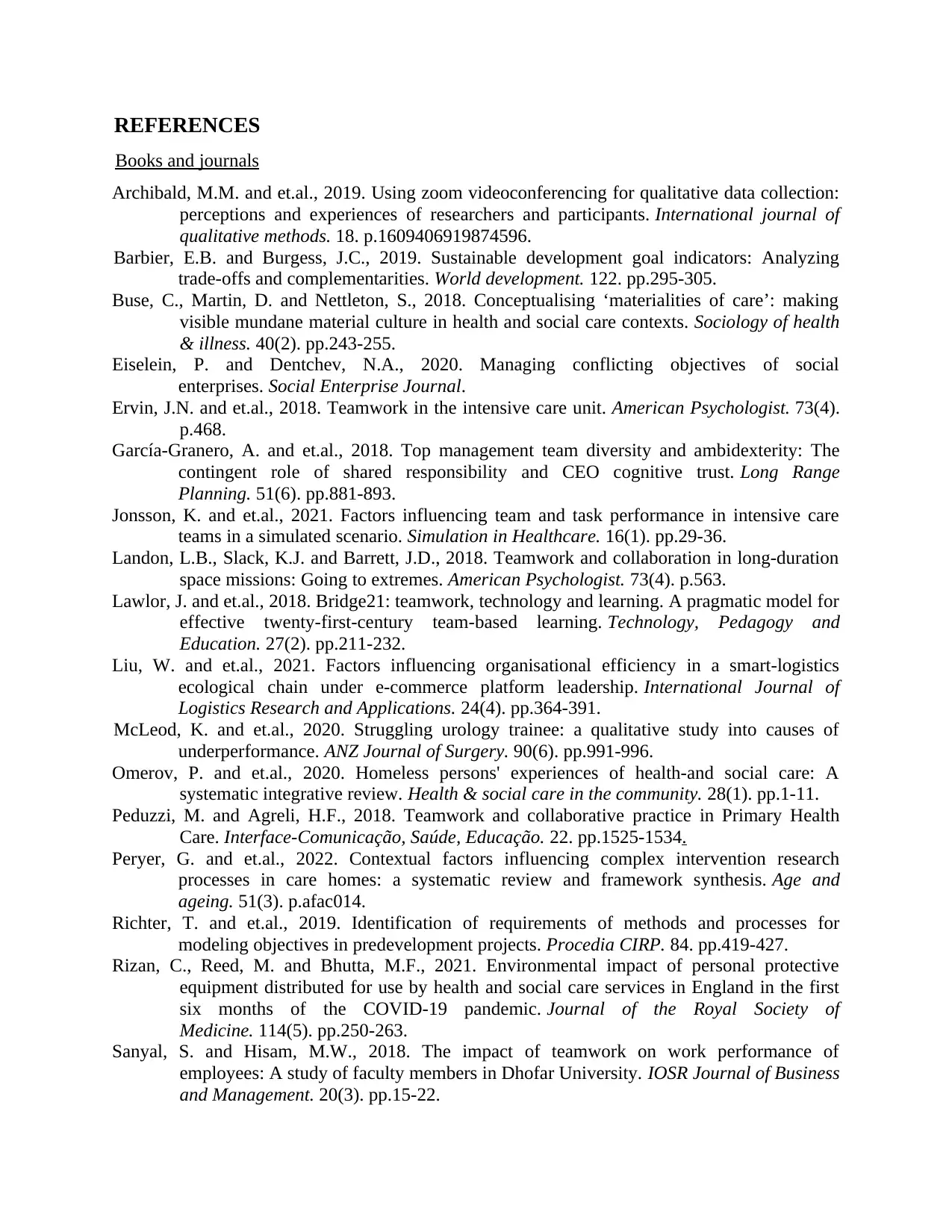
REFERENCES
Books and journals
Archibald, M.M. and et.al., 2019. Using zoom videoconferencing for qualitative data collection:
perceptions and experiences of researchers and participants. International journal of
qualitative methods. 18. p.1609406919874596.
Barbier, E.B. and Burgess, J.C., 2019. Sustainable development goal indicators: Analyzing
trade-offs and complementarities. World development. 122. pp.295-305.
Buse, C., Martin, D. and Nettleton, S., 2018. Conceptualising ‘materialities of care’: making
visible mundane material culture in health and social care contexts. Sociology of health
& illness. 40(2). pp.243-255.
Eiselein, P. and Dentchev, N.A., 2020. Managing conflicting objectives of social
enterprises. Social Enterprise Journal.
Ervin, J.N. and et.al., 2018. Teamwork in the intensive care unit. American Psychologist. 73(4).
p.468.
García-Granero, A. and et.al., 2018. Top management team diversity and ambidexterity: The
contingent role of shared responsibility and CEO cognitive trust. Long Range
Planning. 51(6). pp.881-893.
Jonsson, K. and et.al., 2021. Factors influencing team and task performance in intensive care
teams in a simulated scenario. Simulation in Healthcare. 16(1). pp.29-36.
Landon, L.B., Slack, K.J. and Barrett, J.D., 2018. Teamwork and collaboration in long-duration
space missions: Going to extremes. American Psychologist. 73(4). p.563.
Lawlor, J. and et.al., 2018. Bridge21: teamwork, technology and learning. A pragmatic model for
effective twenty-first-century team-based learning. Technology, Pedagogy and
Education. 27(2). pp.211-232.
Liu, W. and et.al., 2021. Factors influencing organisational efficiency in a smart-logistics
ecological chain under e-commerce platform leadership. International Journal of
Logistics Research and Applications. 24(4). pp.364-391.
McLeod, K. and et.al., 2020. Struggling urology trainee: a qualitative study into causes of
underperformance. ANZ Journal of Surgery. 90(6). pp.991-996.
Omerov, P. and et.al., 2020. Homeless persons' experiences of health‐and social care: A
systematic integrative review. Health & social care in the community. 28(1). pp.1-11.
Peduzzi, M. and Agreli, H.F., 2018. Teamwork and collaborative practice in Primary Health
Care. Interface-Comunicação, Saúde, Educação. 22. pp.1525-1534.
Peryer, G. and et.al., 2022. Contextual factors influencing complex intervention research
processes in care homes: a systematic review and framework synthesis. Age and
ageing. 51(3). p.afac014.
Richter, T. and et.al., 2019. Identification of requirements of methods and processes for
modeling objectives in predevelopment projects. Procedia CIRP. 84. pp.419-427.
Rizan, C., Reed, M. and Bhutta, M.F., 2021. Environmental impact of personal protective
equipment distributed for use by health and social care services in England in the first
six months of the COVID-19 pandemic. Journal of the Royal Society of
Medicine. 114(5). pp.250-263.
Sanyal, S. and Hisam, M.W., 2018. The impact of teamwork on work performance of
employees: A study of faculty members in Dhofar University. IOSR Journal of Business
and Management. 20(3). pp.15-22.
Books and journals
Archibald, M.M. and et.al., 2019. Using zoom videoconferencing for qualitative data collection:
perceptions and experiences of researchers and participants. International journal of
qualitative methods. 18. p.1609406919874596.
Barbier, E.B. and Burgess, J.C., 2019. Sustainable development goal indicators: Analyzing
trade-offs and complementarities. World development. 122. pp.295-305.
Buse, C., Martin, D. and Nettleton, S., 2018. Conceptualising ‘materialities of care’: making
visible mundane material culture in health and social care contexts. Sociology of health
& illness. 40(2). pp.243-255.
Eiselein, P. and Dentchev, N.A., 2020. Managing conflicting objectives of social
enterprises. Social Enterprise Journal.
Ervin, J.N. and et.al., 2018. Teamwork in the intensive care unit. American Psychologist. 73(4).
p.468.
García-Granero, A. and et.al., 2018. Top management team diversity and ambidexterity: The
contingent role of shared responsibility and CEO cognitive trust. Long Range
Planning. 51(6). pp.881-893.
Jonsson, K. and et.al., 2021. Factors influencing team and task performance in intensive care
teams in a simulated scenario. Simulation in Healthcare. 16(1). pp.29-36.
Landon, L.B., Slack, K.J. and Barrett, J.D., 2018. Teamwork and collaboration in long-duration
space missions: Going to extremes. American Psychologist. 73(4). p.563.
Lawlor, J. and et.al., 2018. Bridge21: teamwork, technology and learning. A pragmatic model for
effective twenty-first-century team-based learning. Technology, Pedagogy and
Education. 27(2). pp.211-232.
Liu, W. and et.al., 2021. Factors influencing organisational efficiency in a smart-logistics
ecological chain under e-commerce platform leadership. International Journal of
Logistics Research and Applications. 24(4). pp.364-391.
McLeod, K. and et.al., 2020. Struggling urology trainee: a qualitative study into causes of
underperformance. ANZ Journal of Surgery. 90(6). pp.991-996.
Omerov, P. and et.al., 2020. Homeless persons' experiences of health‐and social care: A
systematic integrative review. Health & social care in the community. 28(1). pp.1-11.
Peduzzi, M. and Agreli, H.F., 2018. Teamwork and collaborative practice in Primary Health
Care. Interface-Comunicação, Saúde, Educação. 22. pp.1525-1534.
Peryer, G. and et.al., 2022. Contextual factors influencing complex intervention research
processes in care homes: a systematic review and framework synthesis. Age and
ageing. 51(3). p.afac014.
Richter, T. and et.al., 2019. Identification of requirements of methods and processes for
modeling objectives in predevelopment projects. Procedia CIRP. 84. pp.419-427.
Rizan, C., Reed, M. and Bhutta, M.F., 2021. Environmental impact of personal protective
equipment distributed for use by health and social care services in England in the first
six months of the COVID-19 pandemic. Journal of the Royal Society of
Medicine. 114(5). pp.250-263.
Sanyal, S. and Hisam, M.W., 2018. The impact of teamwork on work performance of
employees: A study of faculty members in Dhofar University. IOSR Journal of Business
and Management. 20(3). pp.15-22.
Secure Best Marks with AI Grader
Need help grading? Try our AI Grader for instant feedback on your assignments.
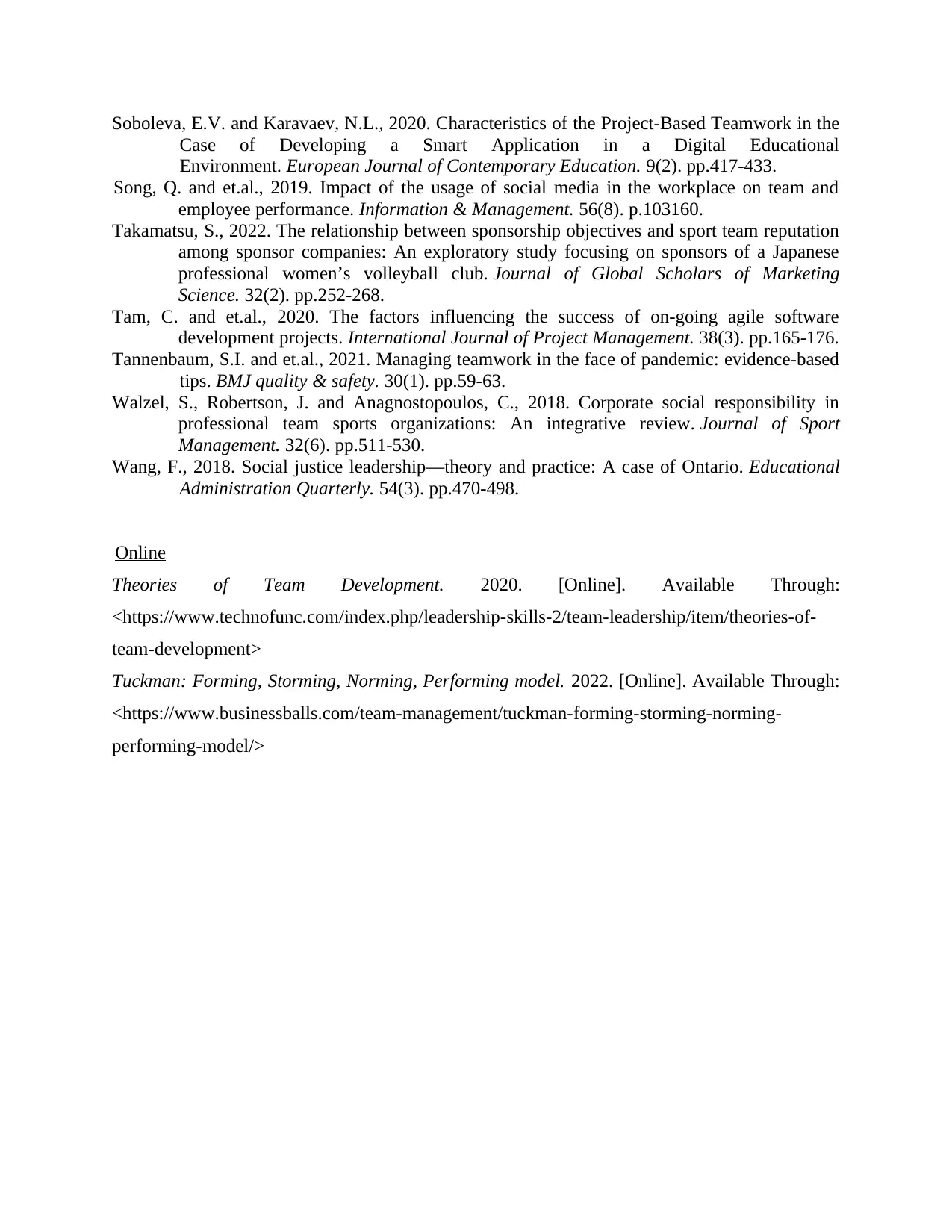
Soboleva, E.V. and Karavaev, N.L., 2020. Characteristics of the Project-Based Teamwork in the
Case of Developing a Smart Application in a Digital Educational
Environment. European Journal of Contemporary Education. 9(2). pp.417-433.
Song, Q. and et.al., 2019. Impact of the usage of social media in the workplace on team and
employee performance. Information & Management. 56(8). p.103160.
Takamatsu, S., 2022. The relationship between sponsorship objectives and sport team reputation
among sponsor companies: An exploratory study focusing on sponsors of a Japanese
professional women’s volleyball club. Journal of Global Scholars of Marketing
Science. 32(2). pp.252-268.
Tam, C. and et.al., 2020. The factors influencing the success of on-going agile software
development projects. International Journal of Project Management. 38(3). pp.165-176.
Tannenbaum, S.I. and et.al., 2021. Managing teamwork in the face of pandemic: evidence-based
tips. BMJ quality & safety. 30(1). pp.59-63.
Walzel, S., Robertson, J. and Anagnostopoulos, C., 2018. Corporate social responsibility in
professional team sports organizations: An integrative review. Journal of Sport
Management. 32(6). pp.511-530.
Wang, F., 2018. Social justice leadership—theory and practice: A case of Ontario. Educational
Administration Quarterly. 54(3). pp.470-498.
Online
Theories of Team Development. 2020. [Online]. Available Through:
<https://www.technofunc.com/index.php/leadership-skills-2/team-leadership/item/theories-of-
team-development>
Tuckman: Forming, Storming, Norming, Performing model. 2022. [Online]. Available Through:
<https://www.businessballs.com/team-management/tuckman-forming-storming-norming-
performing-model/>
Case of Developing a Smart Application in a Digital Educational
Environment. European Journal of Contemporary Education. 9(2). pp.417-433.
Song, Q. and et.al., 2019. Impact of the usage of social media in the workplace on team and
employee performance. Information & Management. 56(8). p.103160.
Takamatsu, S., 2022. The relationship between sponsorship objectives and sport team reputation
among sponsor companies: An exploratory study focusing on sponsors of a Japanese
professional women’s volleyball club. Journal of Global Scholars of Marketing
Science. 32(2). pp.252-268.
Tam, C. and et.al., 2020. The factors influencing the success of on-going agile software
development projects. International Journal of Project Management. 38(3). pp.165-176.
Tannenbaum, S.I. and et.al., 2021. Managing teamwork in the face of pandemic: evidence-based
tips. BMJ quality & safety. 30(1). pp.59-63.
Walzel, S., Robertson, J. and Anagnostopoulos, C., 2018. Corporate social responsibility in
professional team sports organizations: An integrative review. Journal of Sport
Management. 32(6). pp.511-530.
Wang, F., 2018. Social justice leadership—theory and practice: A case of Ontario. Educational
Administration Quarterly. 54(3). pp.470-498.
Online
Theories of Team Development. 2020. [Online]. Available Through:
<https://www.technofunc.com/index.php/leadership-skills-2/team-leadership/item/theories-of-
team-development>
Tuckman: Forming, Storming, Norming, Performing model. 2022. [Online]. Available Through:
<https://www.businessballs.com/team-management/tuckman-forming-storming-norming-
performing-model/>
1 out of 17
Related Documents
Your All-in-One AI-Powered Toolkit for Academic Success.
+13062052269
info@desklib.com
Available 24*7 on WhatsApp / Email
![[object Object]](/_next/static/media/star-bottom.7253800d.svg)
Unlock your academic potential
© 2024 | Zucol Services PVT LTD | All rights reserved.





